
2024 Approved Easy Steps to Translate Video on Twitter

2024 Easy Steps to Translate Video on Twitter
Do you want people around the world to watch your videos on Twitter? What about those who might want to watch but don’t speak your language? Without video translation, you’re missing out on reaching many potential viewers.**Translating Twitter videos lets you connect with audiences from different cultures and languages.
Translated videos also lead to better engagement. Viewers are more likely to watch accurately translated videos on Twitter. If your video has a bad translation, you could lose viewers. Translations help more people to understand your content. That way, they will have a chance to share your video. This leads to higher engagement with viewers worldwide.
If you have videos that need translating, we’re here to help and guide you through the process.
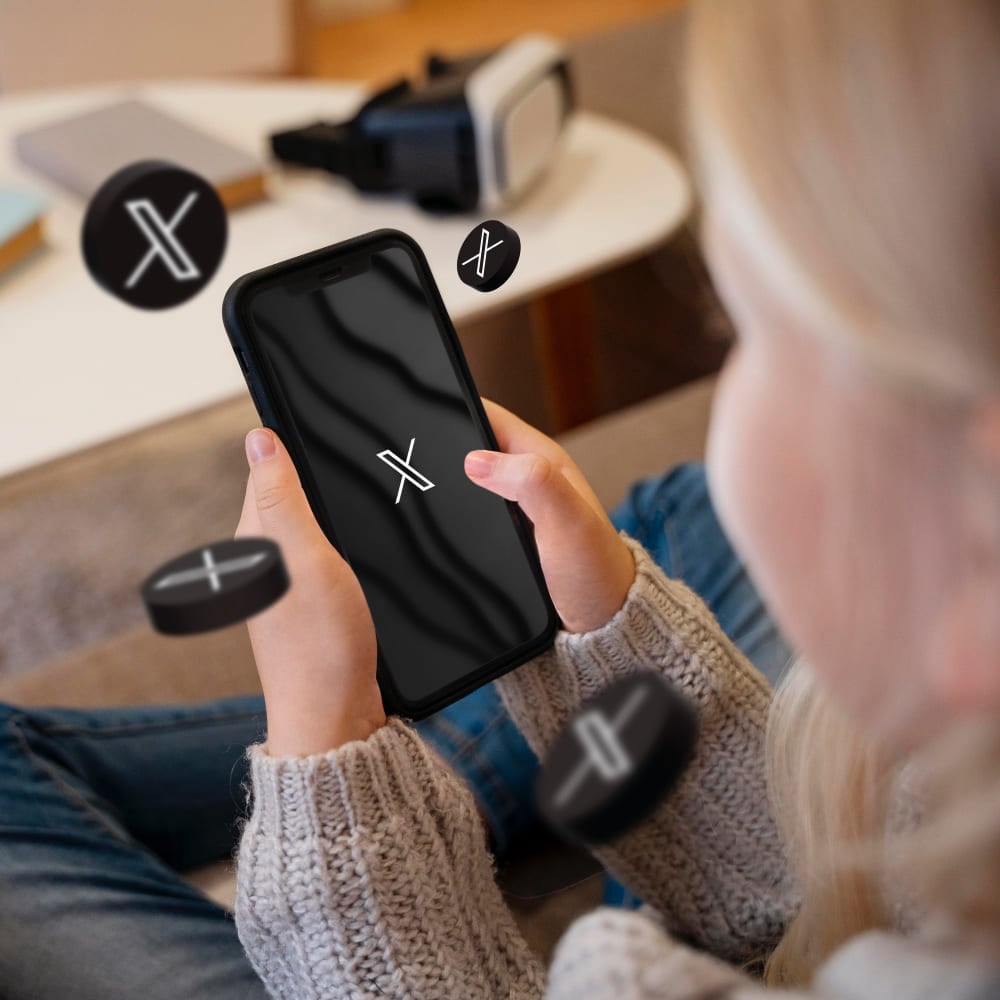
Part 1. Why Translate Twitter Video?
Twitter has a vast user base worldwide. It offers an unparalleled opportunity to connect with diverse audiences. But the language barrier often stands as a significant obstacle. **Translating Twitter videos addresses this challenge head-on. By offering many benefits beyond mere language comprehension.
Here’s some benefit of translating video:
- Accessibility to diverse audiences
When you translate videos on Twitter, you’re breaking down language barriers. So everyone, no matter their language, can understand your content. This means more people connect with you, opening to diverse communities worldwide.
- Increased reach and engagement
Translating videos helps you reach more people on Twitter. If your content speaks different languages, more viewers can engage with it. Making your message go further and have more impact.
- Building a more inclusive online community
By translating your videos, you’re making Twitter a more welcoming place for everyone. Regardless of their language. This builds a stronger community where diverse voices are valued and heard.
Part 2. Are There Built-in Translation Features on Twitter for Video?
Twitter has limited features in terms of translation. Currently, Twitter only allows the translation of text within tweets. There are no built-in features for translating video content directly on the platform. But, you can enable closed captions to aid in understanding video content.
Here are the steps to turn on closed captions videos on Twitter:
- Step 1. Open the Twitter app or website and find the video tweet that you want to watch with closed captions. This tweet could be in your timeline or a user’s profile.
- Step 2. Tap the video’s thumbnail to play the video.
- Step 3. Tap on the three dots at the top right of the screen to bring up the video player controls.

- Step 4. Look for the closed captions (CC) icon on the video player controls. It usually appears as a small icon with the letters “Captions” or “CC” inside a rectangle. Tap on this icon to turn on closed captions.
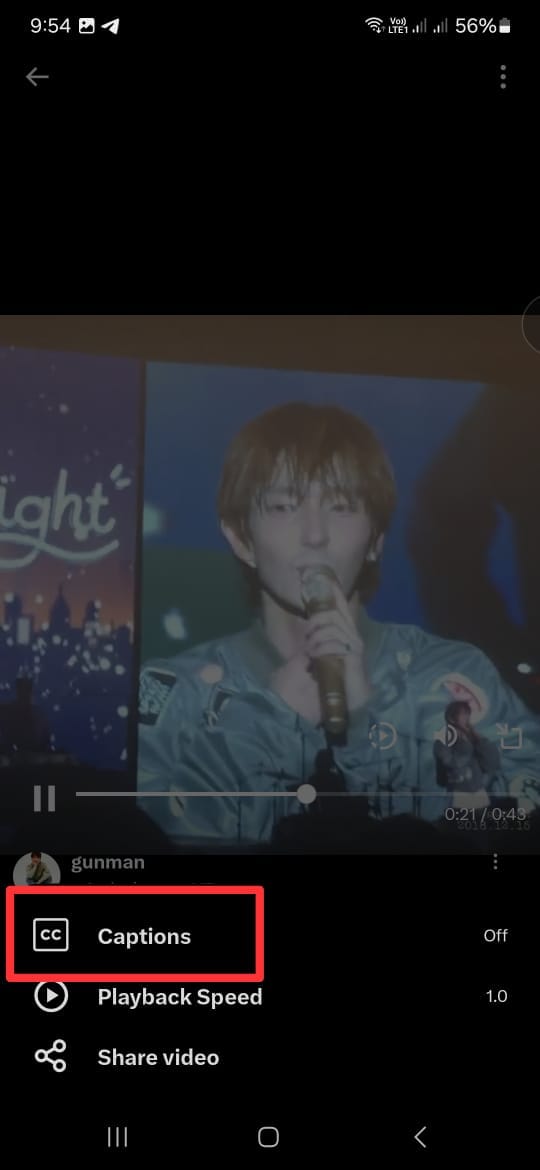
- Step 5. Once closed captions are enabled, watch the video as usual. You should see text at the bottom of the screen that provides a written transcription of the audio content.
However, closed captions on Twitter are not perfect. Not every video on Twitter shows this feature. That’s why this feature is not a popular option for many users.
Part 3. How to Translate Twitter Video With Twitter Translator Bots
Users must use external tools such as bot accounts and AI video translators to translate videos on Twitter. These tools can help translate video content on Twitter. Making it more accessible to diverse audiences. While **Twitter video translation features are limited, alternative methods can overcome these language barriers.
Using bot accounts on Twitter to translate videos involves a few steps:
- Step 1. Find a Translation Bot Account
Look for bot accounts on Twitter specifically designed for translation purposes. Some of them are @TranslateMom, @Translatevidapp, and @vidtranslator. These accounts are programmed to translate video to text-based content automatically.
- Step 2. Follow the Bot Account
Once you’ve found a suitable translation bot account, they usually require you to follow them to receive the translations.
- Step 3. Tag the Bot Account
When you find a video tweet you want to translate, reply to that tweet and tag the translation bot account. You can mention the bot account’s username and request a translation.
- Step 4. Wait for Translation
The translation bot account will automatically respond to your tweet with the translated text. Depending on the bot’s processing time and availability, this may take a few moments.
- Step 5. Review the Translations
Once you receive the translation, review it to ensure accuracy and readability. Remember that automated translations may not always be perfect. So, use your judgment to assess the quality of the translation.
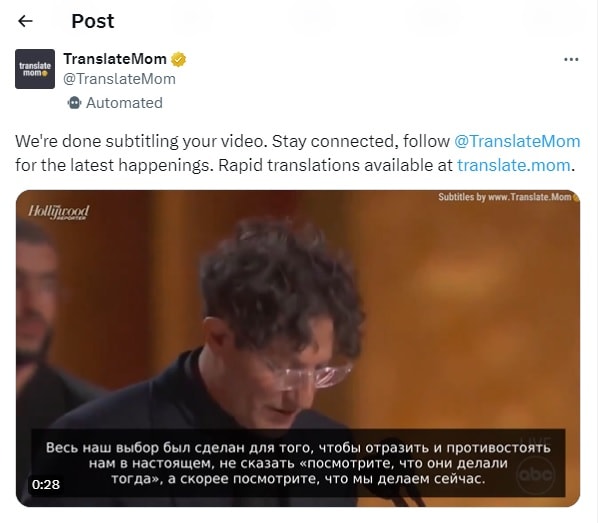
Another option that you have to translate videos on Twitter is using AI Video Translator. There are many software that have AI Video Translator features. But if you want to use those tools without installing anything, the next section will discuss how to do it online.
Part 4. How to Translate Twitter Video With AI Video Translator
One standout tool to **translate twitter videos online is by using Wondershare Virbo Video Translator . This tool is designed to translate videos and give users accessibility across linguistic boundaries.
Virbo’s Video Translator stands out as the go-to solution for several reasons. Its advanced AI algorithms ensure accurate and natural translations and preserve the essence and tone of the original content. Moreover, its user-friendly interface makes it easy to translate videos with just a few clicks.
Key features of Virbo’s Video Translator include:
- Automatic Translation
Virbo uses cutting-edge AI technology to automatically translate video content, eliminating the need for manual transcription and translation.
- Multiple Language Support
Virbo supports a wide range of languages. Enables creators to reach diverse audiences worldwide.
- Customization Option
You can customize translations to suit your preferences, adjusting language style and tone settings.
- Subtitle Integration
Virbo integrates translated subtitles into the video, ensuring a seamless viewing experience for viewers.
To translate Twitter videos using Virbo Video Translator, you can follow these simple steps:
- Step 1. Go to Wondershare Virbo and select “Generate AI Video Online .”
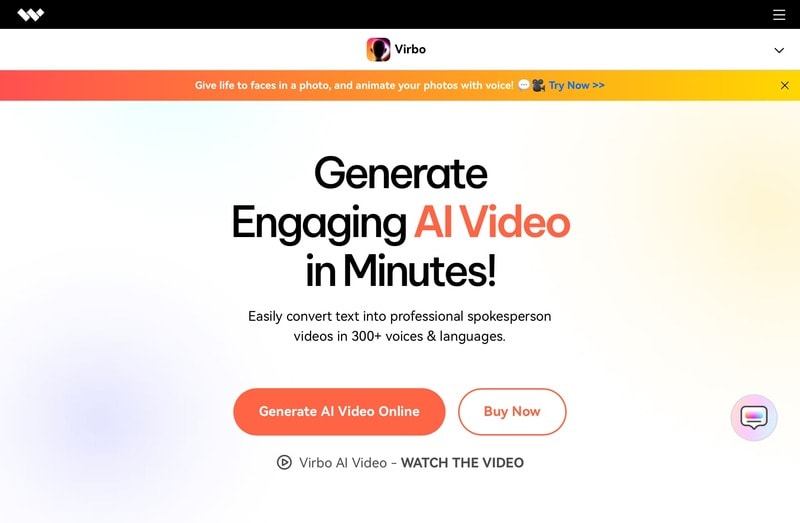
Get Started Online Free Download
- Step 2. Log in or create a new account.
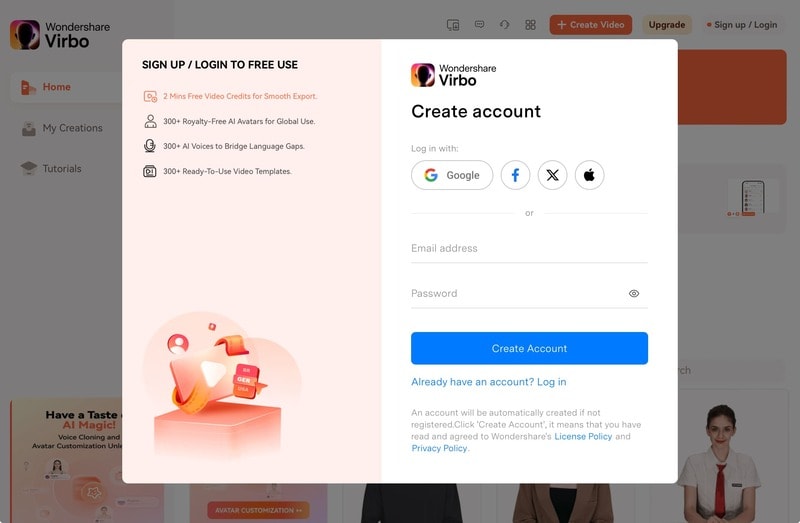
- Step 3. Open the Video Translate feature.
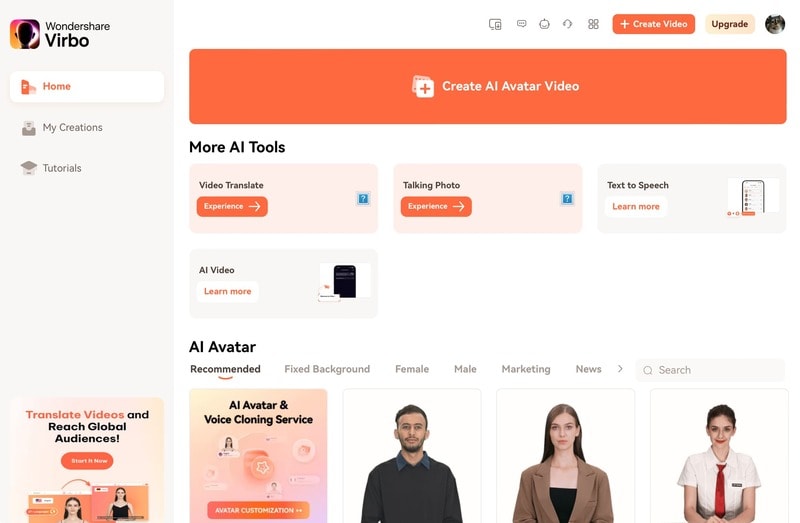
- Step 4. Upload the video you want to translate. Specify the original language and choose the target language. You can activate the Lip Sync feature for accurate audio translation aligned with lip movements or enable the Subtitle feature.
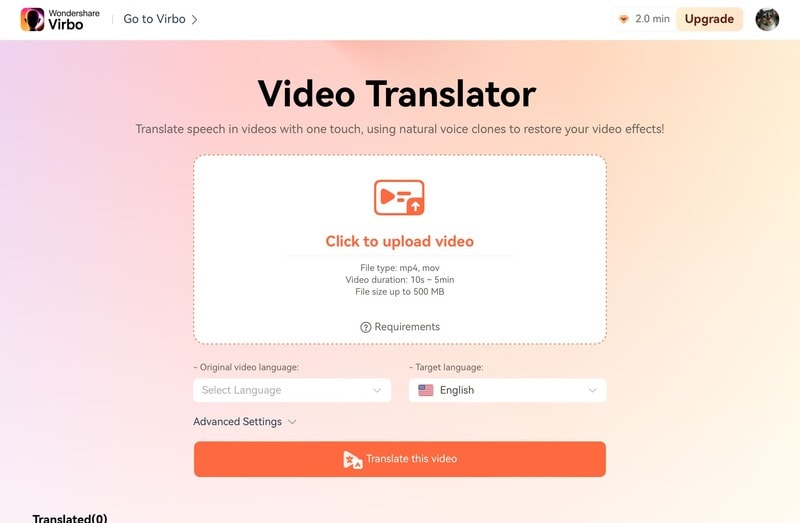
- Step 5. Click “Translate this video”, then the system will translate the audio and synchronize it with the video. Note that processing time may vary depending on the video’s duration and complexity.
Using Virbo’s Translation tool makes translating Twitter’s video online easier. It helps you reach more people and break through language barriers effortlessly. With Virbo’s smart AI technology, connecting with a worldwide audience is simple and leaves a significant impact.
Conclusion
Translating videos on Twitter is not just about overcoming language barriers. It’s about expanding your reach, fostering inclusivity, and enhancing engagement. Translating the video makes your content accessible to diverse audiences worldwide. Hence, it creates a more connected and vibrant online community.
While Twitter’s built-in translation feature is limited, other tools exist. For example, you can use translation bot accounts or AI Video Translators. One of the best solutions is using the AI Video Translator tool by Wondershare Virbo. These tools are easy to use and help you connect with people worldwide.
So, if you want your Twitter videos to reach a wider audience and make a more significant impact, try Virbo’s Video Translator tool. It’s simpler than you think, and it’s worth it.
Get Started Online Free Download

Must-Have Apps for Real-Time Video Translation
Want to watch a video on YouTube, but the captions are in a language you don’t understand? Maybe you have an upcoming work call with international colleagues. Or perhaps you want to catch a live stream, but the language barrier throws you off. Even watching video content on social media apps can feel frustrating when the influencers speak a different language.
So, what can you do? Are there any apps that can translate a live video playing on your device? If any of these scenarios sound familiar, then keep reading. This article will show you the best real time video translation tools around. We’ll help you bridge the language gap and conquer video content, no matter what language it’s in.

Part 1: Overview of the Best Tools for Real-Time Video Translation
Choosing the right tool to translate videos in real-time can be tricky, so it’s important to understand what you need it for first. Don’t worry, though! Here’s a list of the best apps that can help you, which we’ll explore in more detail next.
| Real Time Video Translation App | Best for (Use Case) | Platform Compatibility | User Ratings |
|---|---|---|---|
| Wondershare Virbo | Advertising, social media, and businesses | Windows, iOS, Android, and web browser | 4.8 out of 5 |
| GlotDojo | Watching on Netflix and YouTube | Browser extension, iOS, and Android | N/A |
| InterSub | Learning new languages | Browser extension in Chrome, MS Edge, and Firefox | 5 out of 5 |
| SyncWords | Watching live-stream videos | Cloud-based | 4.7 out of 5 |
| Wordly | Remote meetings | Most event platforms and service providers | 4.4 out of 5 |
| Interprefy | Live broadcasts and watching on YouTube | iOS, Android, cloud-based | 4.6 out of 5 |
| EventMobi | Virtual events | Web browser, iOS, and Android | 4.6 out of 5 |

Part 2: Top 7 Live and Real Time Video Translation Apps
Here’s the detailed information of helpful real time video translation apps to streamline your personal or professional tasks, covering aspects like watching on Netflix, Youtube, or virtual events.
Wondershare Virbo: Best Real Time Video Translation App for Global Audiences

Get Started Online Free Download
Want your ads and other video content to go global? That’s possible. Wondershare Virbo lets you translate a video in real-time into over 20 languages, seamlessly integrating with your workflow. It’s easy to use, so you can instantly expand your reach and engage new audiences. Even better, Virbo’s AI voice cloning ensures perfect audio and visual harmony. So go multilingual and watch your business and social media accounts take off.
Effortlessly streamline your workflow with these powerful features:
- Auto-generate scripts: No more writer’s block; Virbo does it for you. Save time and ensure consistency by having Virbo automatically write your video script.
- Lip-sync precision: No more viewers cringing at awkward pauses or out-of-sync voices. Virbo ensures that translated audio matches lip movements. Imagine your travel vlogs feeling as authentic in Spanish as they do in English.
- AI cloning voices: Give your video personality with AI-powered voice cloning. This emotional connection keeps viewers engaged and understands your message.
- Affordable excellence: Spend within your means. Get high-quality AI video translation solutions at budget-friendly plans.
- Versatile compatibility: Access Virbo from anywhere, on your smartphone, online, or as software on your Windows desktop. This flexibility makes Virbo the perfect video translator app for any content creator.
Pros
- Convenient to use and fast results
- Cross-platform compatibility
- It has an intuitive interface
Cons
- The free plan has restrictions on video length and export options
- Some features are still under development
GlotDojo: Best Real Time Video Translation App for Watching

Ever struggle to understand a funny cooking show on Netflix or a catchy music video from YouTube in another language? GlotDojo can help while you’re watching. It’s a real time video translation app that works on videos from social media apps and streaming services.
Forget switching tabs or pausing constantly. Subtitles appear as you watch so you can understand everything on the fly. This way, you can focus on enjoying the video while learning new words and phrases. So, next time you find a great video in another language, try GlotDojo.
Pros
- Can instantly translate videos on different platforms such as CNN, Amazon, Twitter, and more
- Adjust video speed, save favorite scenes, and repeat/delay subtitles
- User-friendly interface
Cons
- Translations provided may not always be 100% accurate
- Dependence on internet connection
InterSub: Best Real Time Video Translation for Language Practice

Love learning languages but are bored with flashcards? InterSub turns your favorite shows on Disney+, YouTube, or TED Talks into fun vocabulary builders. Instead of just watching passively, you can translate the video in real time by hovering over any word you don’t know. InterSub instantly gives you the definition or translates it into your native language.
Plus, save words you want to remember and quiz yourself later. So, if you want to spice up your video experience and learn a new language along the way, check out InterSub.
Pros
- Engaging in language learning
- Can translate the subtitles of videos while playing
Cons
- Limited to specific streaming services
- Currently unavailable for Safari and mobile devices
SyncWords: Best App To Translate Live Stream Video in Real Time

Do captions and subtitles move too slowly? Want to understand live streams of influencers, gamers, or sellers in another language as they happen? SyncWords offers live captioning. This cloud-based platform uses AI to provide real-time translation for videos.
SyncWords works with live streams that translate the audio into different languages with AI voice dubbing. So, if you face a language barrier, SyncWords can break it down and keep you in the loop.
Pros
- No software installation is needed
- API integration
- Supports translation of over 100+ languages
Cons
- Limited pricing information on their website
- Might struggle with unclear audio, accents, or technical jargon, leading to inaccuracies
Wordly: Best Real Time Translation of Video for Remote Meetings

Planning a business meeting with overseas colleagues but worried about language barriers? Wordly is here to help! It’s a platform that goes beyond simple translation, specializing in conferences. Wordly offers real-time video translation, providing live captions in each participant’s language. It fosters clear communication and a productive meeting environment. So, next time you need to bridge the language gap for a global event, consider Wordly.
Pros
- Scalability works for events with up to 100,000+ attendees
- Integration with various video and event management platforms
- Personalized customer support
Cons
- Might not be suitable for everyone’s budget
- Limited customization options
Interprefy: Best Live Broadcast and YouTube Real Time Translation

Frustrated by YouTube videos without captions? Interprefy can be your bridge to understanding. It’s a cloud-based solution designed specifically for meetings and events, but it works wonders for YouTube videos. Interprefy connects you with professional translators who provide real-time translation on YouTube. When you find a fascinating YouTube video in another language, Interprefy can help you unlock its content.
Pros
- Integration with more platforms like Zoom, Teams, and more
- Can also do close captions and live subtitles
Cons
- Won’t work in areas with bad internet connection
- Takes time to get used to for organizers and attendees
EventMobi: Best Live Video Translation App for Virtual Events

Have a multilingual event but worried about keeping everyone engaged? EventMobi has you covered! This virtual event platform goes beyond scheduling. EventMobi offers seamless integration with services like Kudo, allowing you to translate the video in real time for your virtual event.
Attendees can choose their preferred language from a dropdown menu, and captions appear below the video stream. This way, everyone can participate and engage, regardless of their native language. EventMobi makes your event inclusive and fosters a global conversation.
Pros
- Schedule the live stream session on the app
- Set engagement levels from listening to joining discussions
Cons
- EventMobi can be expensive, especially for smaller events
- Limited design flexibility
Part 3: Considerations and Limitations of Real-Time Video Translation
While the tools above offer exciting possibilities, it’s important to understand their limitations. Here are some considerations when choosing a real-time video translation app. This way, when you use these tools, you’ll know what to expect and what might have some challenges.
Accuracy
Even the best human translators sometimes struggle with complex sentences, slang, or thick accents. Real-time translation of videos using AI is similar. While it’s constantly learning, it might misunderstand some things. So, keep things simple and clear in your videos, especially if your audience might need real-time translation.
Latency
Imagine you’re having a conversation, but there’s a slight pause between your words and the other person’s response. It throws things off a bit, right? That’s kind of what latency is like in real-time video translation. There’s a short delay between what’s spoken and the translated text appearing. For critical conversations, consider using pre-recorded videos with translated subtitles or voiceovers.
Supported Languages
Apps that translate videos in real-time are getting better at handling a wider range of languages, but some are more supported than others. Check the app you’re considering and the languages it supports. If your language isn’t on the list, you might need to look for alternative solutions.

Conclusion
Real-time video translation tools are breaking down language barriers faster. Imagine watching a foreign news report and understanding it instantly or conversing with someone who speaks another language live.
The apps listed here are powerful, but choosing the right one depends on your needs. If you want to understand the content, real-time translation is perfect. But consider AI voice cloning if you need to create videos with a specific voice.
For seamless real-time translation, check out Virbo. It’s a great option to help you bridge the language gap and connect with the world in a new way.

Part 2: Top 7 Live and Real Time Video Translation Apps
Here’s the detailed information of helpful real time video translation apps to streamline your personal or professional tasks, covering aspects like watching on Netflix, Youtube, or virtual events.
Wondershare Virbo: Best Real Time Video Translation App for Global Audiences

Get Started Online Free Download
Want your ads and other video content to go global? That’s possible. Wondershare Virbo lets you translate a video in real-time into over 20 languages, seamlessly integrating with your workflow. It’s easy to use, so you can instantly expand your reach and engage new audiences. Even better, Virbo’s AI voice cloning ensures perfect audio and visual harmony. So go multilingual and watch your business and social media accounts take off.
Effortlessly streamline your workflow with these powerful features:
- Auto-generate scripts: No more writer’s block; Virbo does it for you. Save time and ensure consistency by having Virbo automatically write your video script.
- Lip-sync precision: No more viewers cringing at awkward pauses or out-of-sync voices. Virbo ensures that translated audio matches lip movements. Imagine your travel vlogs feeling as authentic in Spanish as they do in English.
- AI cloning voices: Give your video personality with AI-powered voice cloning. This emotional connection keeps viewers engaged and understands your message.
- Affordable excellence: Spend within your means. Get high-quality AI video translation solutions at budget-friendly plans.
- Versatile compatibility: Access Virbo from anywhere, on your smartphone, online, or as software on your Windows desktop. This flexibility makes Virbo the perfect video translator app for any content creator.
Pros
- Convenient to use and fast results
- Cross-platform compatibility
- It has an intuitive interface
Cons
- The free plan has restrictions on video length and export options
- Some features are still under development
GlotDojo: Best Real Time Video Translation App for Watching

Ever struggle to understand a funny cooking show on Netflix or a catchy music video from YouTube in another language? GlotDojo can help while you’re watching. It’s a real time video translation app that works on videos from social media apps and streaming services.
Forget switching tabs or pausing constantly. Subtitles appear as you watch so you can understand everything on the fly. This way, you can focus on enjoying the video while learning new words and phrases. So, next time you find a great video in another language, try GlotDojo.
Pros
- Can instantly translate videos on different platforms such as CNN, Amazon, Twitter, and more
- Adjust video speed, save favorite scenes, and repeat/delay subtitles
- User-friendly interface
Cons
- Translations provided may not always be 100% accurate
- Dependence on internet connection
InterSub: Best Real Time Video Translation for Language Practice

Love learning languages but are bored with flashcards? InterSub turns your favorite shows on Disney+, YouTube, or TED Talks into fun vocabulary builders. Instead of just watching passively, you can translate the video in real time by hovering over any word you don’t know. InterSub instantly gives you the definition or translates it into your native language.
Plus, save words you want to remember and quiz yourself later. So, if you want to spice up your video experience and learn a new language along the way, check out InterSub.
Pros
- Engaging in language learning
- Can translate the subtitles of videos while playing
Cons
- Limited to specific streaming services
- Currently unavailable for Safari and mobile devices
SyncWords: Best App To Translate Live Stream Video in Real Time

Do captions and subtitles move too slowly? Want to understand live streams of influencers, gamers, or sellers in another language as they happen? SyncWords offers live captioning. This cloud-based platform uses AI to provide real-time translation for videos.
SyncWords works with live streams that translate the audio into different languages with AI voice dubbing. So, if you face a language barrier, SyncWords can break it down and keep you in the loop.
Pros
- No software installation is needed
- API integration
- Supports translation of over 100+ languages
Cons
- Limited pricing information on their website
- Might struggle with unclear audio, accents, or technical jargon, leading to inaccuracies
Wordly: Best Real Time Translation of Video for Remote Meetings

Planning a business meeting with overseas colleagues but worried about language barriers? Wordly is here to help! It’s a platform that goes beyond simple translation, specializing in conferences. Wordly offers real-time video translation, providing live captions in each participant’s language. It fosters clear communication and a productive meeting environment. So, next time you need to bridge the language gap for a global event, consider Wordly.
Pros
- Scalability works for events with up to 100,000+ attendees
- Integration with various video and event management platforms
- Personalized customer support
Cons
- Might not be suitable for everyone’s budget
- Limited customization options
Interprefy: Best Live Broadcast and YouTube Real Time Translation

Frustrated by YouTube videos without captions? Interprefy can be your bridge to understanding. It’s a cloud-based solution designed specifically for meetings and events, but it works wonders for YouTube videos. Interprefy connects you with professional translators who provide real-time translation on YouTube. When you find a fascinating YouTube video in another language, Interprefy can help you unlock its content.
Pros
- Integration with more platforms like Zoom, Teams, and more
- Can also do close captions and live subtitles
Cons
- Won’t work in areas with bad internet connection
- Takes time to get used to for organizers and attendees
EventMobi: Best Live Video Translation App for Virtual Events

Have a multilingual event but worried about keeping everyone engaged? EventMobi has you covered! This virtual event platform goes beyond scheduling. EventMobi offers seamless integration with services like Kudo, allowing you to translate the video in real time for your virtual event.
Attendees can choose their preferred language from a dropdown menu, and captions appear below the video stream. This way, everyone can participate and engage, regardless of their native language. EventMobi makes your event inclusive and fosters a global conversation.
Pros
- Schedule the live stream session on the app
- Set engagement levels from listening to joining discussions
Cons
- EventMobi can be expensive, especially for smaller events
- Limited design flexibility
Part 3: Considerations and Limitations of Real-Time Video Translation
While the tools above offer exciting possibilities, it’s important to understand their limitations. Here are some considerations when choosing a real-time video translation app. This way, when you use these tools, you’ll know what to expect and what might have some challenges.
Accuracy
Even the best human translators sometimes struggle with complex sentences, slang, or thick accents. Real-time translation of videos using AI is similar. While it’s constantly learning, it might misunderstand some things. So, keep things simple and clear in your videos, especially if your audience might need real-time translation.
Latency
Imagine you’re having a conversation, but there’s a slight pause between your words and the other person’s response. It throws things off a bit, right? That’s kind of what latency is like in real-time video translation. There’s a short delay between what’s spoken and the translated text appearing. For critical conversations, consider using pre-recorded videos with translated subtitles or voiceovers.
Supported Languages
Apps that translate videos in real-time are getting better at handling a wider range of languages, but some are more supported than others. Check the app you’re considering and the languages it supports. If your language isn’t on the list, you might need to look for alternative solutions.

Conclusion
Real-time video translation tools are breaking down language barriers faster. Imagine watching a foreign news report and understanding it instantly or conversing with someone who speaks another language live.
The apps listed here are powerful, but choosing the right one depends on your needs. If you want to understand the content, real-time translation is perfect. But consider AI voice cloning if you need to create videos with a specific voice.
For seamless real-time translation, check out Virbo. It’s a great option to help you bridge the language gap and connect with the world in a new way.
Best Video Language Changers to Make Your Videos Accessible
A language barrier can come between the videos or people due to not understanding the language. In this case, a video language changer comes in. If you wisely choose the language changer, you can get accurate translations of videos. If you are searching for the best online video language changer, then this article is for you. We will suggest you the top 5 video language changers.
Part 1. Video Language Changers are Essential to Remove Language Barriers
Video language changers play an essential role in changing the audio of the video from its original language to another language. If you want to get the attention of a large audience, then you have to check their preferences.
1. Promote Your Brand Through Video Language Changer
Promotional videos are a great way to grab the attention of the viewers. A video can help sell services or products because we can transform it into various languages. Add voice-overs, subtitles, and captions to make it more accessible.
2. Add Subtitles to Your YouTube Videos
Subtitles also help people to understand the content of the video. They are best for deaf people who cannot listen to the conversation but understand it through captions or subtitles. YouTube provides the facility of a built-in subtitles option where users can select their desired language.
Part 2: Meet Wondershare Virbo – The Easiest Video Language Changer Ever
Are you looking for an all-in-one software that translates your video or provides a creative look to your video? No worries 

Change Video Language Online Download APP Now Free Download
To change video languages, all you need is to go to the online interface of Virbo and upload your MP4 file. Select the original language of the video and your desired language for translation. It is simple to use, and you can use its features for free.
It also offers 300+ video templates that allow you to create engaging videos. If you are making a marketing video, then you can try the AI avatar features of Virbo. This feature enables you to select the gender, accents, tone, style, and language of the avatar.
This tool will help you to boost your creativity in creating videos and transforming them into a masterpiece. Whether you are a beginner, it assists you in effectively using the built-in templates and editing features.
Key Features of Virbo:
- It can translate videos into 20+ languages, and breaks the language barrier easily!
- It offers to export Full HD formats such as MP4 or WebM.
- Convert your written text to speech in multiple languages. Virbo supports 120+ languages to transform your text into engaging audio.
- It provides a royalty-free stock of music that users can use in their videos without any hassle.
2.1: How to Use Wondershare Virbo Video Translator Online
How to translate videos online? Directly over the internet, using the Wondershare Virbo Online version. Here’s how to use Wondershare Virbo to translate videos online.
Step 1: Visit the Wondershare Virbo Online website and, if you are not already signed in, click the Sign Up/ Login button at the top right. You will be asked to sign in with any of your login credentials for Google, Facebook, Twitter, or Apple ID. If you have a Wondershare Account already, use that, else sign in with any of those to associate that email and create a Wondershare Account.
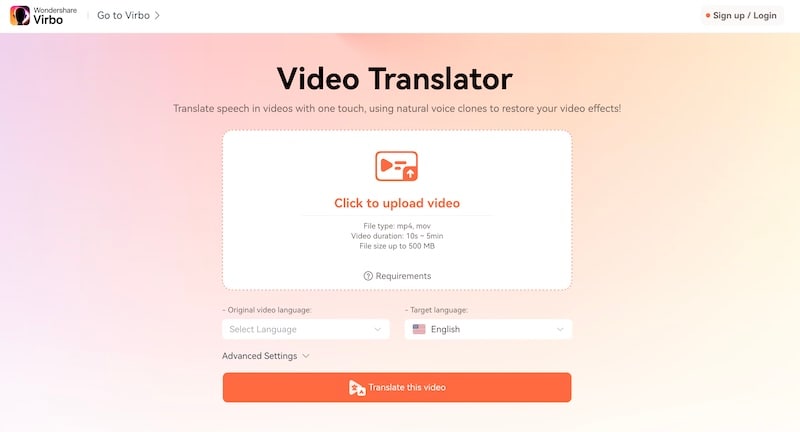
Step 2: Then, add a video, noting the input requirements mentioned. You can either drop the video into the app or click to add. Select the original language and the language you want to translate into.
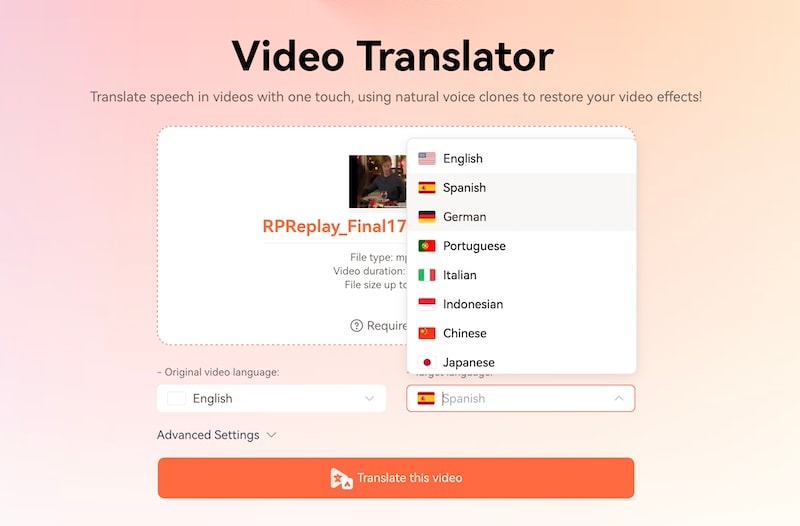
Step 3: Click Translate and when the video is translated, you can save it to disk.
ADVANCED FEATURES
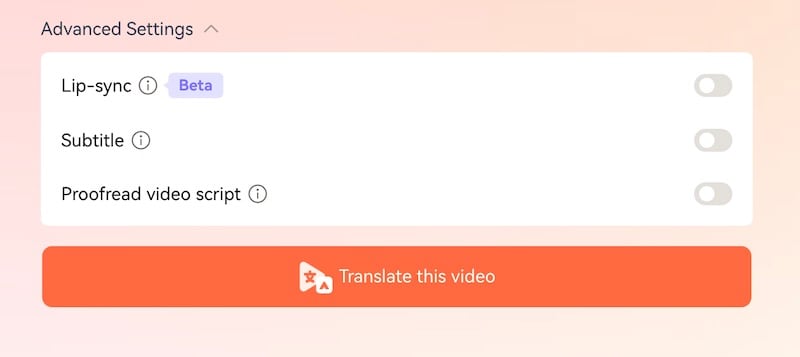
- You can add subtitles in the translated language to the video, provided there are no subtitles already existing in the video, by enabling Subtitles.
- Under some conditions, you can even have the video lip-synced to the translated audio!
2.2: How to Use Wondershare Virbo Video Translator on Windows PC
Using Wondershare Virbo to translate videos is a simple, 3-step process. Just like all other Wondershare software, it is the easiest video translator you could find on the internet. Here’s how to use Wondershare Virbo to translate videos.
Step 1: Download Wondershare Virbo and select the Video Translator option.
Change Video Language Online Download APP Now Free Download
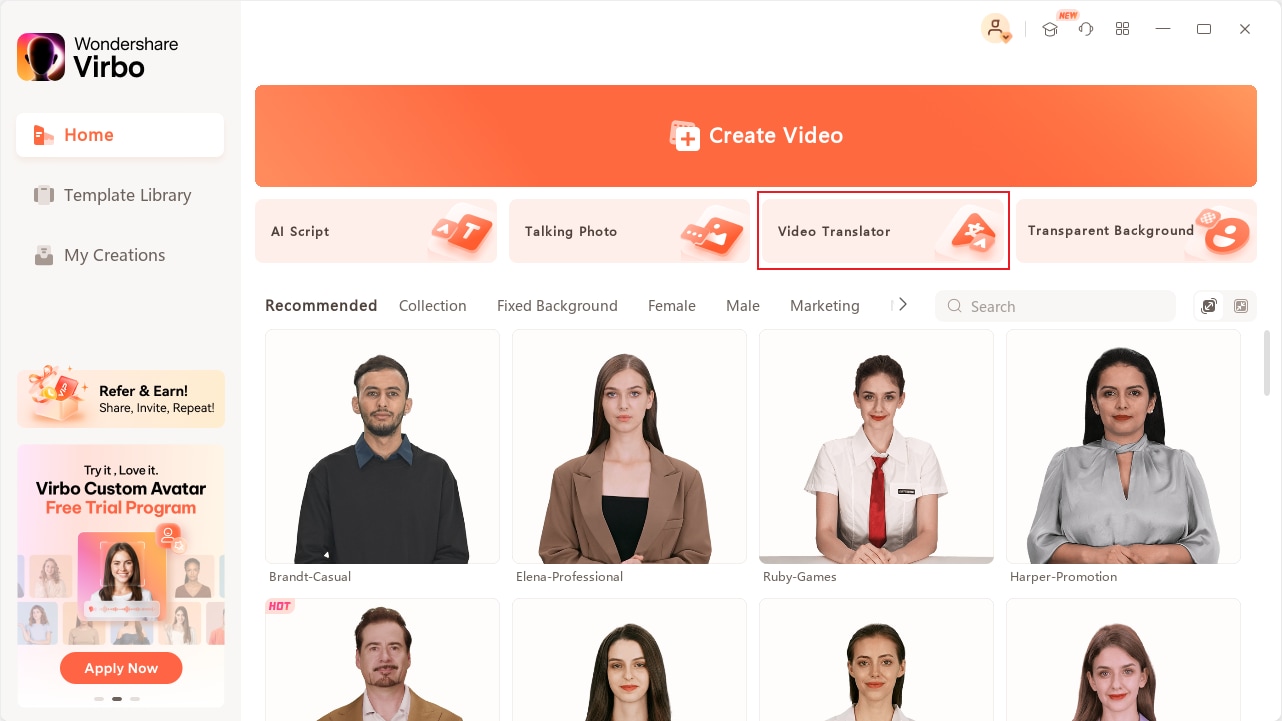
Step 2: A popup will appear for you to upload your videos.
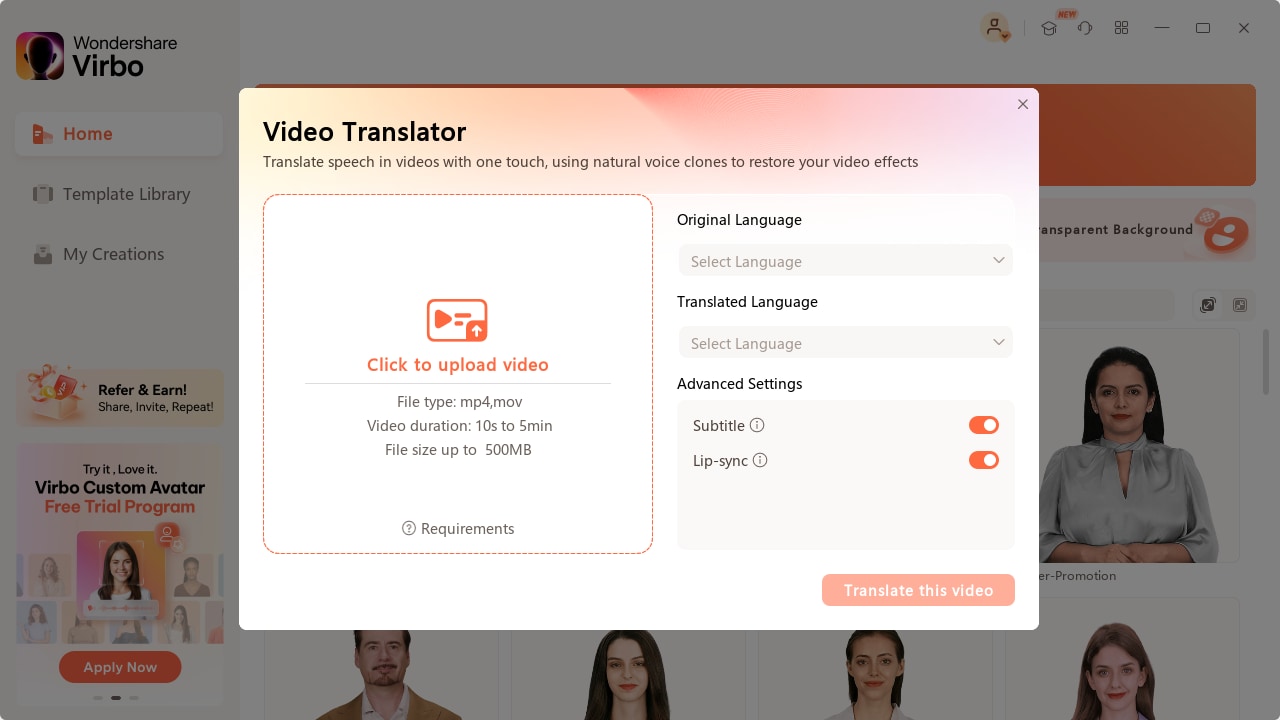
INPUT REQUIREMENTS
There are certain input requirements to the videos you can upload and translate.
- Video resolution must be between 360p x 360p and 1920p x 1920p.
- The minimum playback duration of the video is 10 seconds and the maximum is 5 minutes. This means that you can translate a video under 5 minutes and over 10 seconds.
- Only authentic human voices will be translated. You cannot translate songs, music, or any other sound.
Check the original language and choose the language to translate into from the dropdown menus.
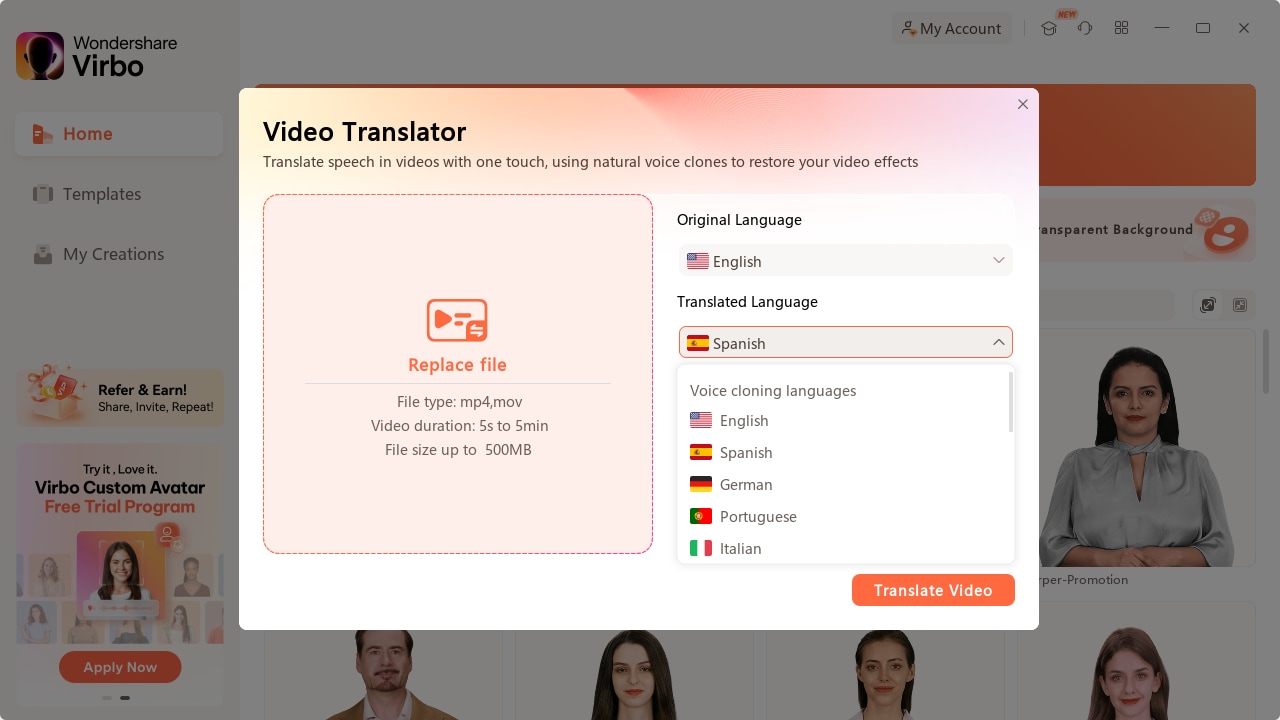
ADVANCED FEATURES
Wondershare Virbo is sprinkled with thoughtful features throughout the video translation experience. One such feature is translating subtitles.
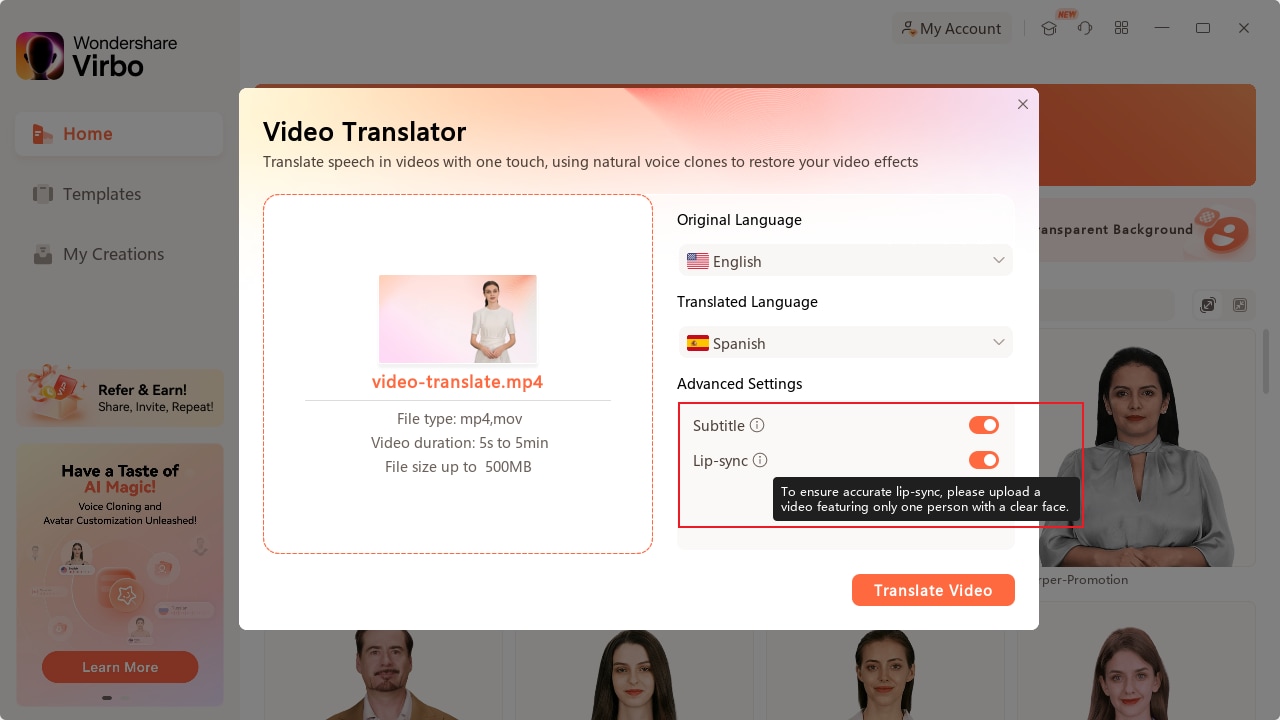
Tick Subtitles if you want video subtitles to be translated. Also, it will keep the background music intact while translating any human voice detected in the video.
Step 3: Click Translate this video and once the video is translated, click Export and save to a location of your choice.
2.3: How to Use Wondershare Virbo Video Translator Mobile App
Wondershare has always been about convenience, and so, you can use Wondershare Virbo even on your smartphone, both iOS and Android! Here’s how to use the Wondershare Virbo app to translate videos on iOS or Android.
Step 1: Download Wondershare Virbo on your smartphone from your corresponding app store (App Store/ Play Store) and sign in/ sign up for an account.
Change Video Language Online Download APP Now Free Download

Wondershare Virbo on iOS allows Guest Login in case you do not want to sign up/ sign in with any of your credentials.
Step 2: Tap AI Video Translator.

Step 3: Upload your video.
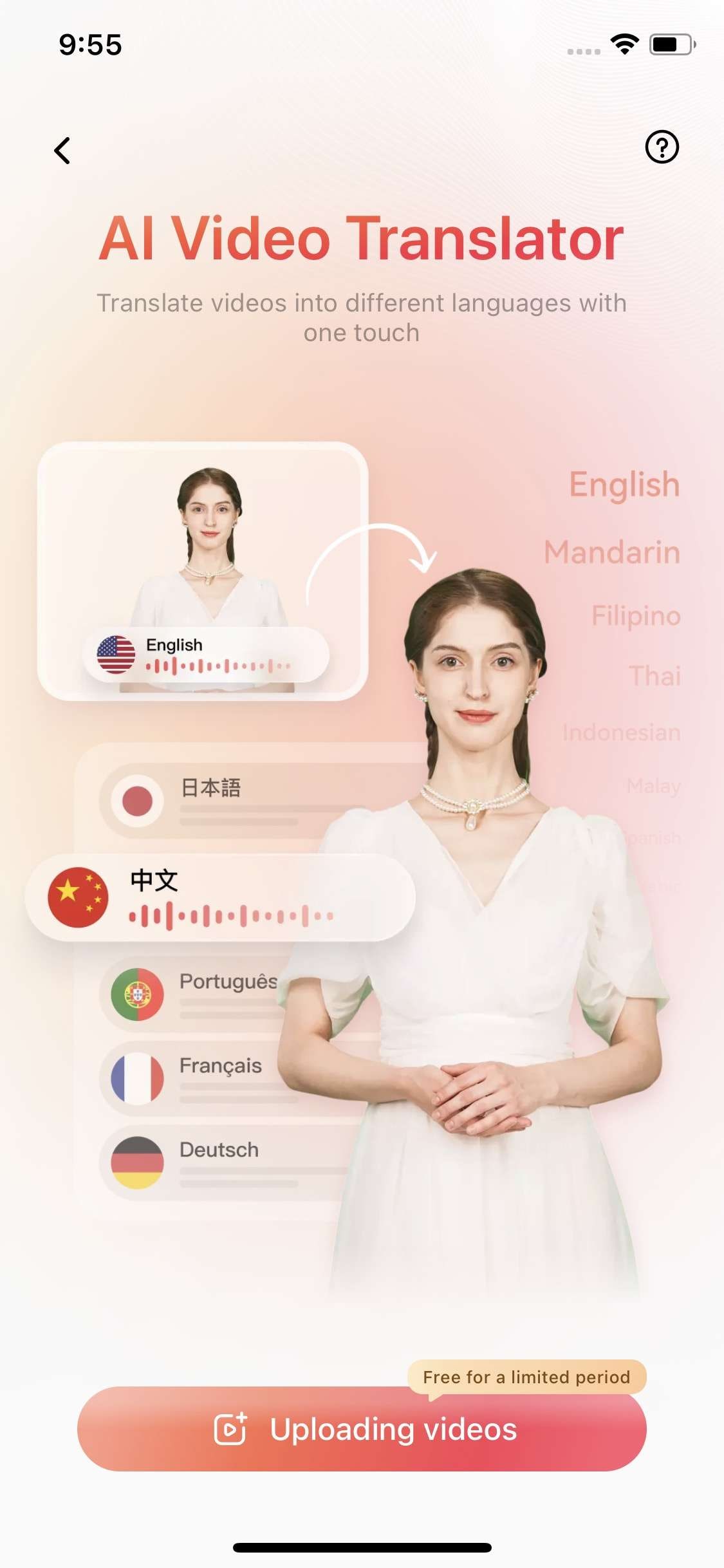
INPUT REQUIREMENTS
There are certain input requirements to the videos you can upload and translate.
- Video resolution must be between 480p x 480p and 1920p x 1920p.
- The minimum playback duration of the video is 10 seconds and the maximum is 5 minutes. This means that you cannot translate a video under 10 seconds and over 2 minutes.
- Only authentic human voices will be translated. You cannot translate songs, music, or any other sound.
Step 4: Select the original language and the target language to translate to.
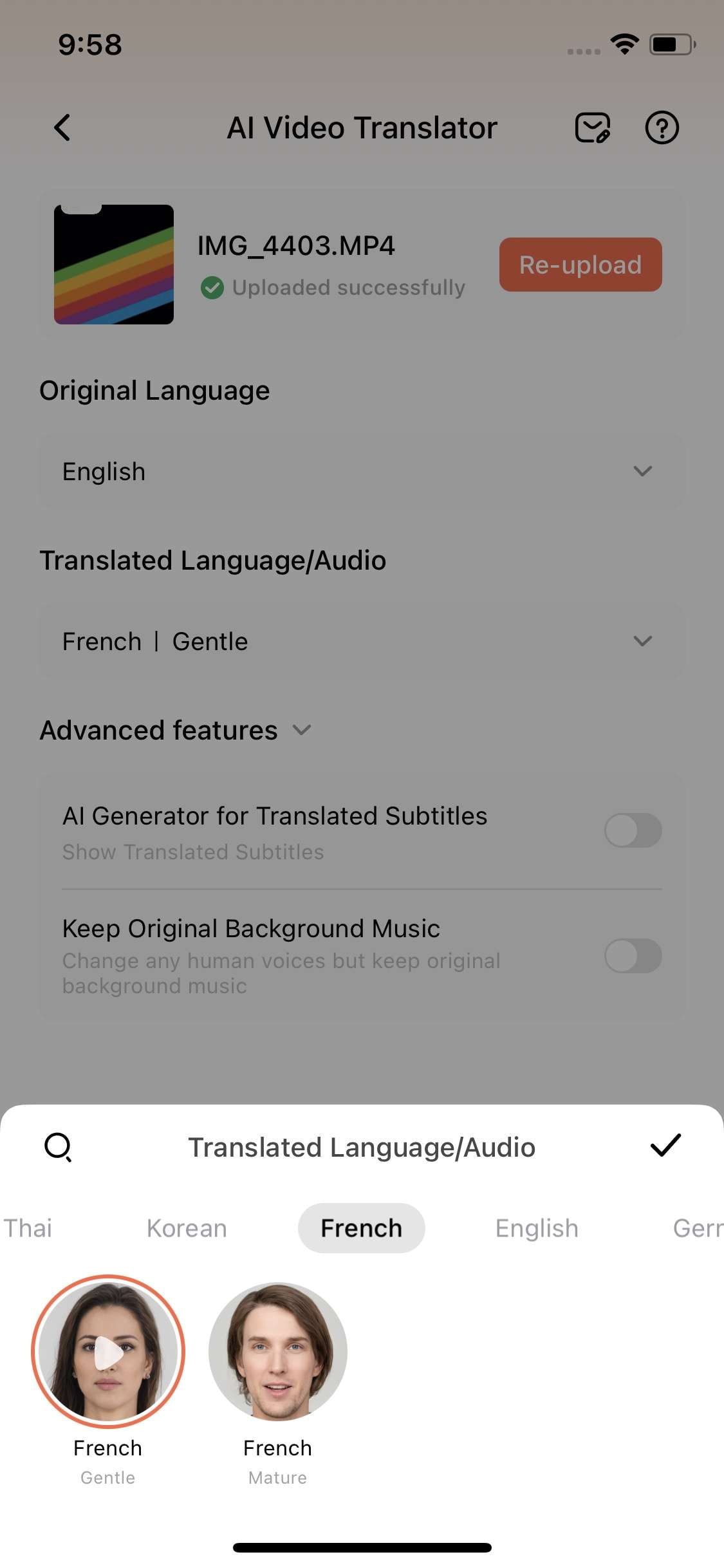
ADVANCED FEATURES
Wondershare Virbo comes with certain advanced features such as translated subtitles and the ability to keep background music intact during translation.
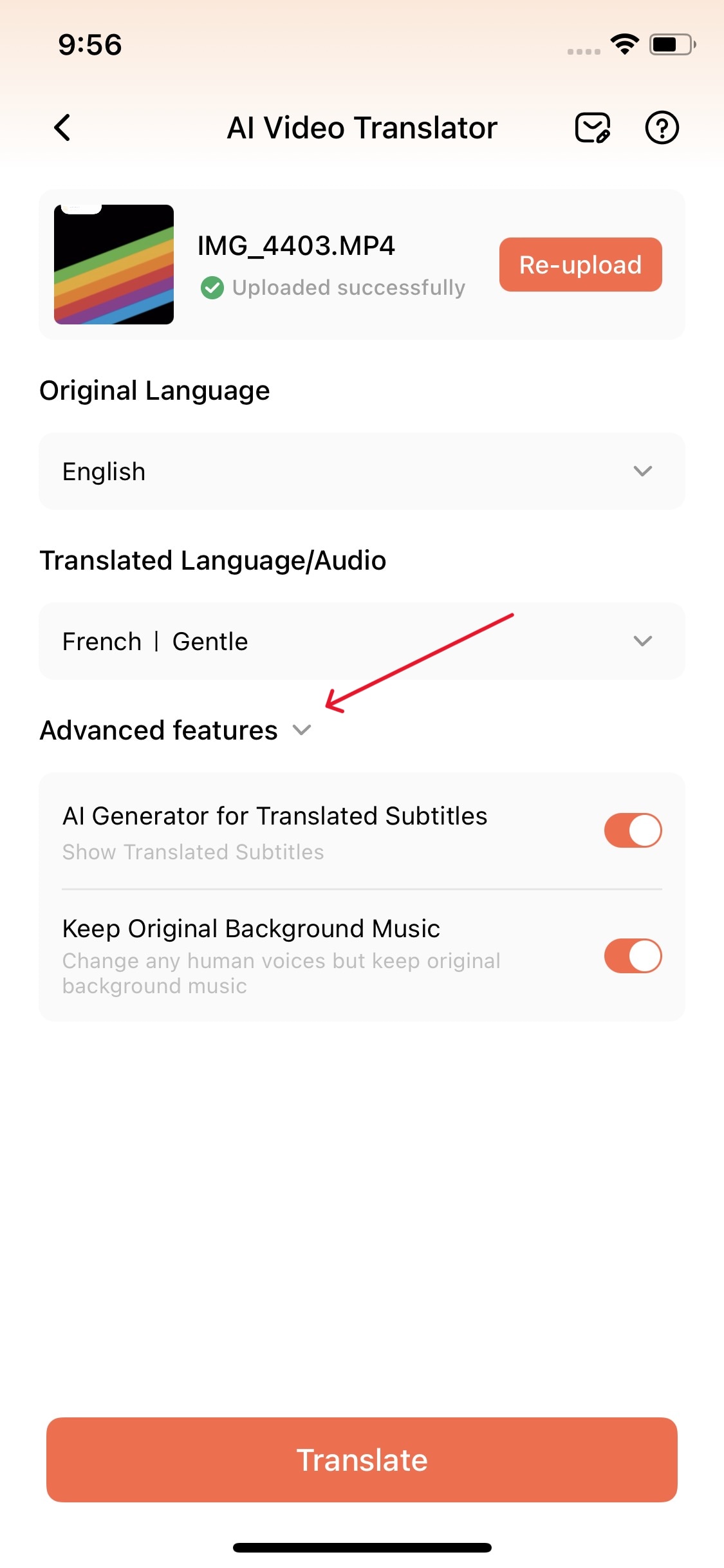
Tap AI Generator for Translated Subtitles to translate video subtitles as well. If you want to keep the background music intact, tap Keep Original Background Music and Virbo will only translate the human voice.
Step 5: Click Translate and when the translation is complete, export the video to a location of your choice.
Change Video Language Online Download APP Now Free Download
Part 3. 4 Other Video Language Changers Online
Unlock the best video language changer, Wondershare Virbo, which allows everyone to translate videos into any language. Creators or marketers can use it to enhance accessibility and connect with audiences across the globe. Here are 4 other online video language changers, exploring their features and functionalities in comparison to Wondershare Virbo.
1. Flixier
Flixier is a free online video language changer that offers to translate videos in 30+ languages. Users only need a good Internet connection to use the features of Flixier. You only need to import the video file, generate subtitles according to your video, and translate them into your desired language. It allows you to export the video within 3 minutes and post it on various platforms.
Flixier allows real-time collaboration with 50+ transitions. As we have discussed, it is a web-based tool, but also allows recording screens and webcams. Its built-in stock library contains thousands of music, videos, and images.
Key Features of Flixier:
- Flixier helps you in customizing the style of your translation. Change the font, color, and size of the translated video according to your preferences.
- It is compatible with all internet browsers and does not require investment to translate videos.
- It enables various importing options such as Google Drive, Dropbox, and Twitch.
2. VEED.IO
The best video language changer always provides accuracy in translating videos. Veed.IO is a language translator that provides instant results with 98.6% accuracy. Users can translate many videos into more than 125 languages. It enables to import of both audio and video to perform the translation process. Transcribe your video first, then transform it into other languages.
It offers a user-friendly interface where users can create videos for the brand effectively. Users can edit the videos on the cloud so that the user can access their files whenever they want. It also allows us to eliminate the background noise and background of the video to make it captivating.
Key Features of VEED.IO:
- Its intuitive timeline adds audio, music, and sound effects to the video. Its stock media library offers a variety of audio tracks that can be added to videos easily.
- Users can also add images to the videos, crop them, add stickers, text, emojis, and more.
- It is free to try and available online on browsers.
3. Kapwing
Kapwing is an online video editor that is powered by artificial intelligence. It is a fast and cost-effective tool that does not require downloading. Users can translate their videos from source languages to more than 70 languages. Due to the latest technology, it saves time to translate the videos and transform them automatically. Translate your videos in various languages, such as Spanish, English, Arabic, Hindi, and more.
It not only translates your videos but can also translate the audio files. Convert multiple videos into text. It exports the text files in SRT, VTT, or TXT formats. Translate your videos and post them on social media platforms to expand your community.
Key Features of Kapwing:
- It does not show you ads while translating videos. It ensures that your information is secure.
- It is a cloud-based video language changer so that users can access it everywhere via the internet.
- It automatically resizes your video according to social media platforms.
4. TYPITO
TYPITO is also an online video language changer that automatically translates every type of video into 100+ languages. You can also download the file of subtitles in SRT format. You can directly translate your videos into web browsers. Generate subtitles and select the language you want to translate your video. Edit the subtitles if necessary, but TYPITO works with 95% of accuracy.
If you want to create YouTube videos and add translation inside the video, you can also try TYPITO. It helps to burn the subtitles files into your video. Adjust the font, size, color, layout, and position of the subtitles before downloading the file. If you are creating an educational video, then you can use styled themes to make your subtitles more attractive.
Key Features of TYPITO:
- It offers more than 20 formats of video and various forms of aspect ratios.
- TYPITO provides an intuitive interface where users can drag and drop the files.
- Generate instant captions for the videos and share them on your favorite social media platform.
- Users can find 200+ templates of various categories such as sports, education, business, etc.
Conclusion
Video language changer is essential in almost every category of videos. Whether you are creating lecture videos, advertising a brand, promoting your business, or creating video content, language changer plays a crucial role in all fields.
What is the best video language changer? Virbo stands with advanced AI technology and ensures the accuracy of the results. Whether you want to translate videos, generate scripts, create voice clones, or add soundtracks, go for Virbo.
Change Video Language Online Download APP Now Free Download
To change video languages, all you need is to go to the online interface of Virbo and upload your MP4 file. Select the original language of the video and your desired language for translation. It is simple to use, and you can use its features for free.
It also offers 300+ video templates that allow you to create engaging videos. If you are making a marketing video, then you can try the AI avatar features of Virbo. This feature enables you to select the gender, accents, tone, style, and language of the avatar.
This tool will help you to boost your creativity in creating videos and transforming them into a masterpiece. Whether you are a beginner, it assists you in effectively using the built-in templates and editing features.
Key Features of Virbo:
- It can translate videos into 20+ languages, and breaks the language barrier easily!
- It offers to export Full HD formats such as MP4 or WebM.
- Convert your written text to speech in multiple languages. Virbo supports 120+ languages to transform your text into engaging audio.
- It provides a royalty-free stock of music that users can use in their videos without any hassle.
2.1: How to Use Wondershare Virbo Video Translator Online
How to translate videos online? Directly over the internet, using the Wondershare Virbo Online version. Here’s how to use Wondershare Virbo to translate videos online.
Step 1: Visit the Wondershare Virbo Online website and, if you are not already signed in, click the Sign Up/ Login button at the top right. You will be asked to sign in with any of your login credentials for Google, Facebook, Twitter, or Apple ID. If you have a Wondershare Account already, use that, else sign in with any of those to associate that email and create a Wondershare Account.

Step 2: Then, add a video, noting the input requirements mentioned. You can either drop the video into the app or click to add. Select the original language and the language you want to translate into.

Step 3: Click Translate and when the video is translated, you can save it to disk.
ADVANCED FEATURES

- You can add subtitles in the translated language to the video, provided there are no subtitles already existing in the video, by enabling Subtitles.
- Under some conditions, you can even have the video lip-synced to the translated audio!
2.2: How to Use Wondershare Virbo Video Translator on Windows PC
Using Wondershare Virbo to translate videos is a simple, 3-step process. Just like all other Wondershare software, it is the easiest video translator you could find on the internet. Here’s how to use Wondershare Virbo to translate videos.
Step 1: Download Wondershare Virbo and select the Video Translator option.
Change Video Language Online Download APP Now Free Download

Step 2: A popup will appear for you to upload your videos.

INPUT REQUIREMENTS
There are certain input requirements to the videos you can upload and translate.
- Video resolution must be between 360p x 360p and 1920p x 1920p.
- The minimum playback duration of the video is 10 seconds and the maximum is 5 minutes. This means that you can translate a video under 5 minutes and over 10 seconds.
- Only authentic human voices will be translated. You cannot translate songs, music, or any other sound.
Check the original language and choose the language to translate into from the dropdown menus.

ADVANCED FEATURES
Wondershare Virbo is sprinkled with thoughtful features throughout the video translation experience. One such feature is translating subtitles.

Tick Subtitles if you want video subtitles to be translated. Also, it will keep the background music intact while translating any human voice detected in the video.
Step 3: Click Translate this video and once the video is translated, click Export and save to a location of your choice.
2.3: How to Use Wondershare Virbo Video Translator Mobile App
Wondershare has always been about convenience, and so, you can use Wondershare Virbo even on your smartphone, both iOS and Android! Here’s how to use the Wondershare Virbo app to translate videos on iOS or Android.
Step 1: Download Wondershare Virbo on your smartphone from your corresponding app store (App Store/ Play Store) and sign in/ sign up for an account.
Change Video Language Online Download APP Now Free Download

Wondershare Virbo on iOS allows Guest Login in case you do not want to sign up/ sign in with any of your credentials.
Step 2: Tap AI Video Translator.

Step 3: Upload your video.

INPUT REQUIREMENTS
There are certain input requirements to the videos you can upload and translate.
- Video resolution must be between 480p x 480p and 1920p x 1920p.
- The minimum playback duration of the video is 10 seconds and the maximum is 5 minutes. This means that you cannot translate a video under 10 seconds and over 2 minutes.
- Only authentic human voices will be translated. You cannot translate songs, music, or any other sound.
Step 4: Select the original language and the target language to translate to.

ADVANCED FEATURES
Wondershare Virbo comes with certain advanced features such as translated subtitles and the ability to keep background music intact during translation.

Tap AI Generator for Translated Subtitles to translate video subtitles as well. If you want to keep the background music intact, tap Keep Original Background Music and Virbo will only translate the human voice.
Step 5: Click Translate and when the translation is complete, export the video to a location of your choice.
Change Video Language Online Download APP Now Free Download
Part 3. 4 Other Video Language Changers Online
Unlock the best video language changer, Wondershare Virbo, which allows everyone to translate videos into any language. Creators or marketers can use it to enhance accessibility and connect with audiences across the globe. Here are 4 other online video language changers, exploring their features and functionalities in comparison to Wondershare Virbo.
1. Flixier
Flixier is a free online video language changer that offers to translate videos in 30+ languages. Users only need a good Internet connection to use the features of Flixier. You only need to import the video file, generate subtitles according to your video, and translate them into your desired language. It allows you to export the video within 3 minutes and post it on various platforms.
Flixier allows real-time collaboration with 50+ transitions. As we have discussed, it is a web-based tool, but also allows recording screens and webcams. Its built-in stock library contains thousands of music, videos, and images.
Key Features of Flixier:
- Flixier helps you in customizing the style of your translation. Change the font, color, and size of the translated video according to your preferences.
- It is compatible with all internet browsers and does not require investment to translate videos.
- It enables various importing options such as Google Drive, Dropbox, and Twitch.
2. VEED.IO
The best video language changer always provides accuracy in translating videos. Veed.IO is a language translator that provides instant results with 98.6% accuracy. Users can translate many videos into more than 125 languages. It enables to import of both audio and video to perform the translation process. Transcribe your video first, then transform it into other languages.
It offers a user-friendly interface where users can create videos for the brand effectively. Users can edit the videos on the cloud so that the user can access their files whenever they want. It also allows us to eliminate the background noise and background of the video to make it captivating.
Key Features of VEED.IO:
- Its intuitive timeline adds audio, music, and sound effects to the video. Its stock media library offers a variety of audio tracks that can be added to videos easily.
- Users can also add images to the videos, crop them, add stickers, text, emojis, and more.
- It is free to try and available online on browsers.
3. Kapwing
Kapwing is an online video editor that is powered by artificial intelligence. It is a fast and cost-effective tool that does not require downloading. Users can translate their videos from source languages to more than 70 languages. Due to the latest technology, it saves time to translate the videos and transform them automatically. Translate your videos in various languages, such as Spanish, English, Arabic, Hindi, and more.
It not only translates your videos but can also translate the audio files. Convert multiple videos into text. It exports the text files in SRT, VTT, or TXT formats. Translate your videos and post them on social media platforms to expand your community.
Key Features of Kapwing:
- It does not show you ads while translating videos. It ensures that your information is secure.
- It is a cloud-based video language changer so that users can access it everywhere via the internet.
- It automatically resizes your video according to social media platforms.
4. TYPITO
TYPITO is also an online video language changer that automatically translates every type of video into 100+ languages. You can also download the file of subtitles in SRT format. You can directly translate your videos into web browsers. Generate subtitles and select the language you want to translate your video. Edit the subtitles if necessary, but TYPITO works with 95% of accuracy.
If you want to create YouTube videos and add translation inside the video, you can also try TYPITO. It helps to burn the subtitles files into your video. Adjust the font, size, color, layout, and position of the subtitles before downloading the file. If you are creating an educational video, then you can use styled themes to make your subtitles more attractive.
Key Features of TYPITO:
- It offers more than 20 formats of video and various forms of aspect ratios.
- TYPITO provides an intuitive interface where users can drag and drop the files.
- Generate instant captions for the videos and share them on your favorite social media platform.
- Users can find 200+ templates of various categories such as sports, education, business, etc.
Conclusion
Video language changer is essential in almost every category of videos. Whether you are creating lecture videos, advertising a brand, promoting your business, or creating video content, language changer plays a crucial role in all fields.
What is the best video language changer? Virbo stands with advanced AI technology and ensures the accuracy of the results. Whether you want to translate videos, generate scripts, create voice clones, or add soundtracks, go for Virbo.
Change Video Language Online Download APP Now Free Download
A Brief Review of CapCut Translate [With Alternative]
Accurate and efficient video translations are essential for reaching global audiences. They bridge linguistic barriers. Translations open doors to diverse viewership and amplify your content’s impact. The article delves into two leading tools for enhancing translations:CapCut Translate and Wondershare Virbo.
The page provides an in-depth comparison and a handy guide for using each tool’s capabilities. Whether it’s auto-translating subtitles or language nuances, these platforms streamline the localization process. Each app ensures your message resonates across borders. Explore the guide for insights and tips to elevate your video content’s reach and relevance. Read on to learn more.

Part 1. CapCut Translate: An Overview
CapCut Translate Subtitles is a nifty app that helps you make accurate and efficient translations of video content. With its intuitive interface, the app bridges language barriers and allows you to reach a diverse audience. Here are its key features of transcribe video to text by Capcut:

- Video-to-text translation
CapCut Translate enables you to translate spoken or written content within videos into text. The auto-translation of CapCut helps create accurate subtitles or transcripts in many languages. It enhances accessibility and comprehension for viewers.
- Multilingual subtitle translation
You can translate subtitles into various languages. The app ensures that your content is accessible to global audiences. It supports a wide range of languages. It’s a versatile tool for international outreach and engagement.
- Customizable subtitles
CapCut offers flexibility in subtitle customization. It allows you to adjust font styles, sizes, colors, and positions. You can suit your preferences or branding requirements. The customization enhances the visual appeal and readability of subtitles, enhancing viewer engagement.
Use Cases
CapCut is a valuable tool for breaking down language barriers. Here are the platform’s different use cases:
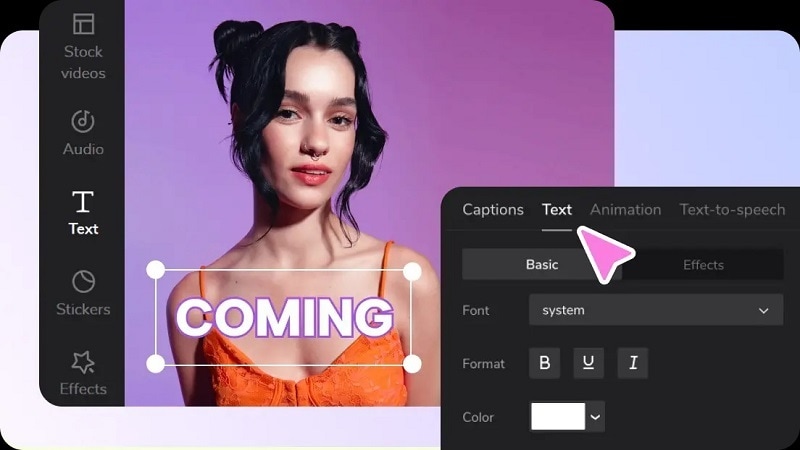
- Global marketing campaigns
CapCut Translate is ideal for businesses conducting international marketing campaigns. By translating videos or ads, companies can communicate with diverse target audiences. It maximizes brand visibility and engagement on a global scale.
- Education for special schools
The app can be used in educational settings. It can be useful for students with linguistic or hearing impairments. Teachers can create translated video lessons or instructional materials with subtitles. It ensures that all students can access and comprehend the content regardless of language barriers.
- International conferences
CapCut helps seamless communication at international conferences or events. It provides real-time translation with a few clicks. The app ensures that participants can engage in the proceedings and discussions.
How To Use Auto Translation With CapCut
Follow the steps below to take advantage of CapCut Translate’s subtitle translator for your videos.
- Step 1: Download and install the application to your computer. Launch the app. Upload the video from your computer to the platform’s interface. You can also upload via Myspace, Google Drive, Dropbox, or QR code.
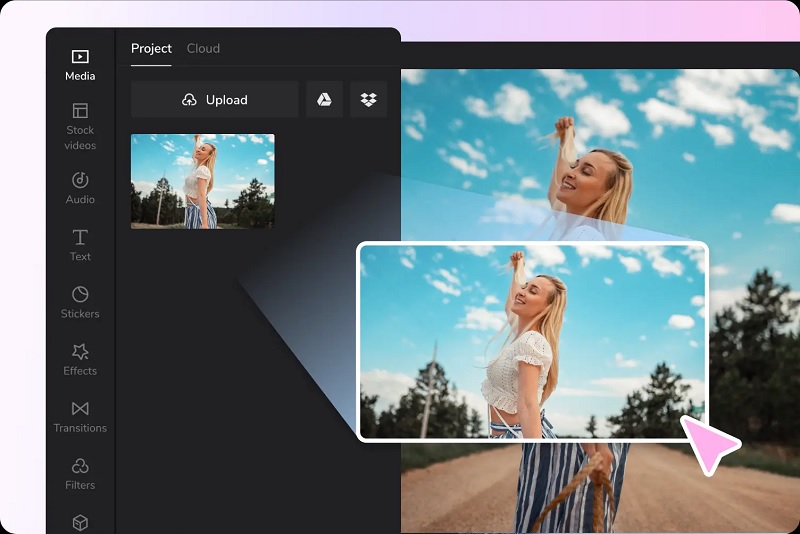
- Step 2: Once the video is uploaded, the app will detect the spoken language in your video. Next, click on Captions > Auto captions > Generate. Next, wait for the CapCut auto caption generator to process the translation.
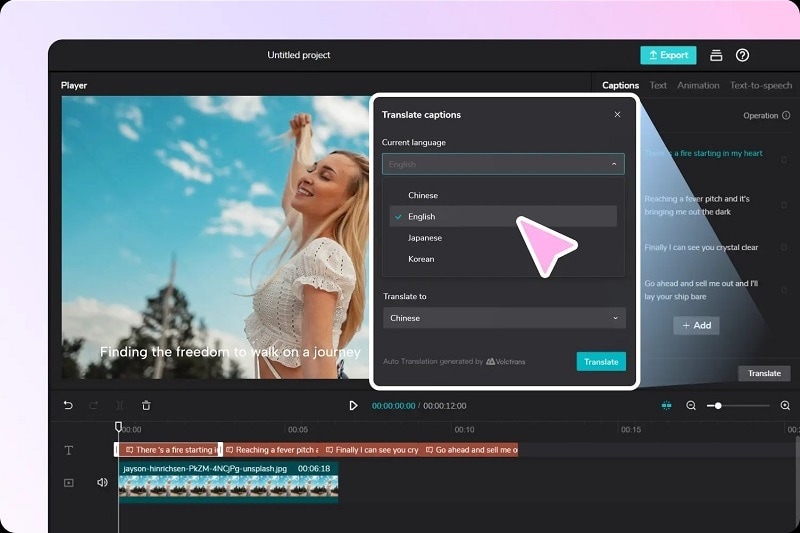
- Step 3: After translating the video content, preview the subtitles to ensure accuracy and formatting. Once satisfied, export the translated video with subtitles embedded. Share it across various platforms or channels to reach your intended audience.

If the auto translation of CapCut isn’t accessible to you, Wondershare Virbo is an excellent alternative. It offers efficient AI-powered translation features with an intuitive interface and robust capabilities.
Part 2. Wondershare Virbo: The Perfect CapCut Alternative Assisted by AI
Wondershare Virbo is an exceptional alternative tool for video translations. Virbo empowers you to translate and enhance your video content for global audiences. Let’s delve into the platform’s key features:

Get Started Online Free Download
- Versatile compatibility. Virbo has an offline and online version. The app ensures seamless integration into your workflow.
- AI cloning voices. Virbo enables you to replicate voices with remarkable accuracy. It’s useful for dubbing or voice-over projects.
- Auto-generate scripts. The app generates scripts based on the audio content of videos. The feature saves time and effort. It allows you to focus on refining and enhancing your content rather than transcribing it.
- Soundtrack reversed. Virbo offers a unique feature that allows you to reverse the soundtrack of videos. It adds a creative dimension to your content.
- Multilingual support. Virbo supports up to 20+ languages to optimize your content.
- Subtitle translation. Virbo can automatically translate the uploaded video’s subtitles. It supports the translation tasks of 28 languages, including English, French, Spanish, German, etc.
Different Use Cases of Wondershare Virbo
With its intuitive interface and robust capabilities, Virbo streamlines the localization process. It saves you time and effort for your video content. Here are use cases where you can take advantage of Virbo:
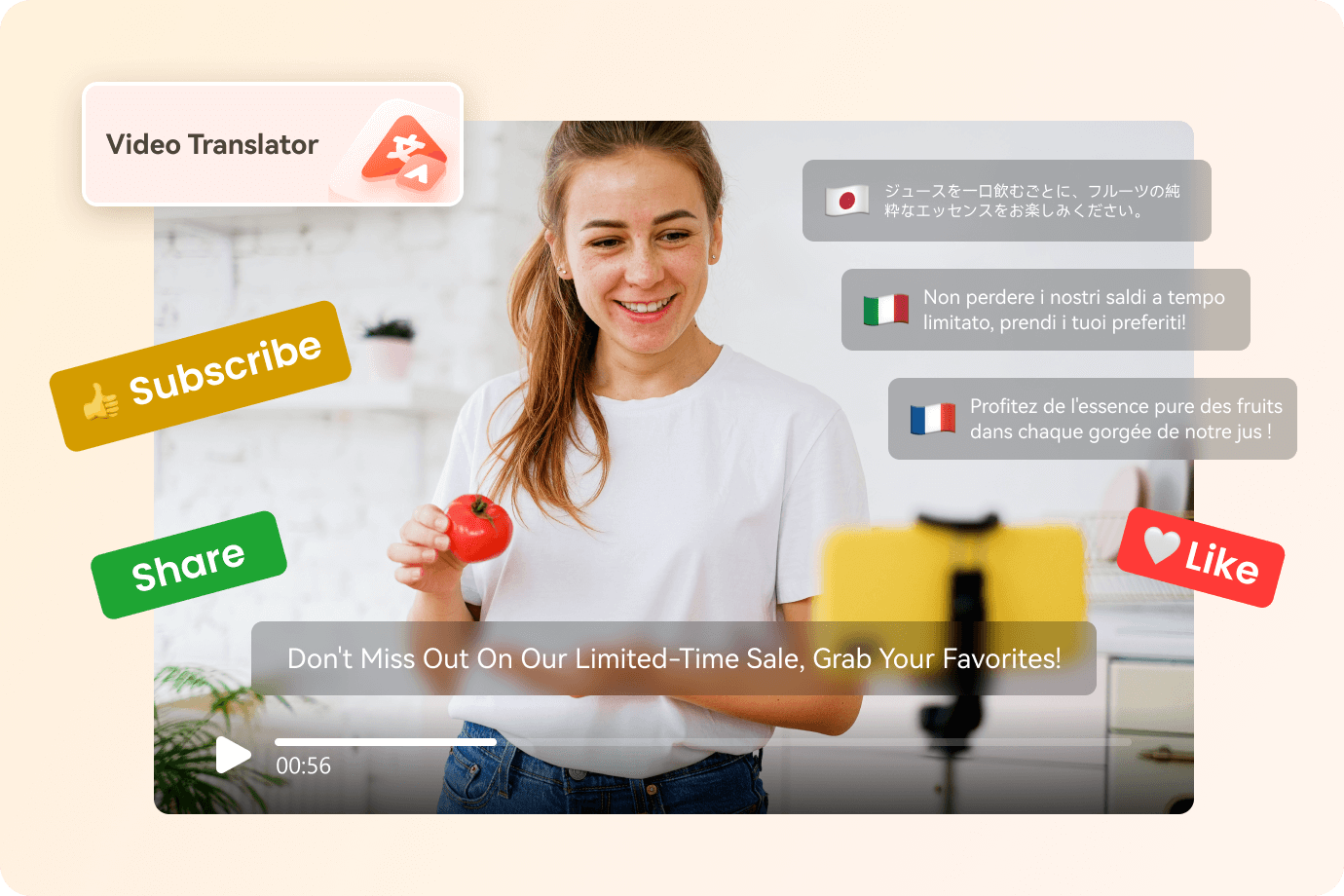
- Video advertising for global impact. Virbo’s AI translation and voice cloning allow companies to localize content for various markets. It maximizes engagement and conversion rates.
- Streamlined media production. Virbo offers automated script generation and voice cloning features. It provides content creators with efficient workflow management.
- Optimized corporate interactions. The app helps in real-time translation and voice cloning for presentations, training videos, and more. It ensures that companies can engage with employees and stakeholders across language barriers.
How To Translate Subtitles With Virbo
Follow these steps to enhance your video content and reach global audiences with Virbo:
- Step 1: Download and install Wondershare Virbo on your computer. You can also use the Virbo online tool . Once installed, launch the app. Log in with your Email, Wondershare, Google, Facebook, or Twitter account. Click the Video Translator button to start the process.
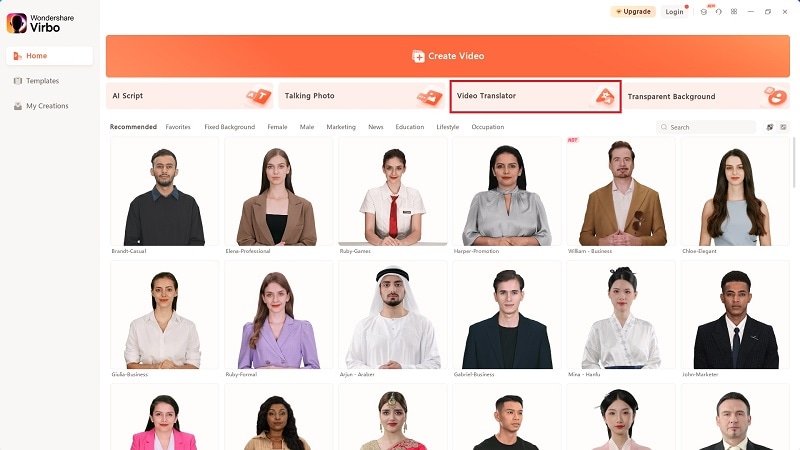
Get Started Online Free Download
- Step 2: Choose the video for translation saved on your computer. Choose the original and translated languages on the right side of the interface. In the advanced settings, decide if you like to add subtitles or lip-sync. Next, click on Translate Video.
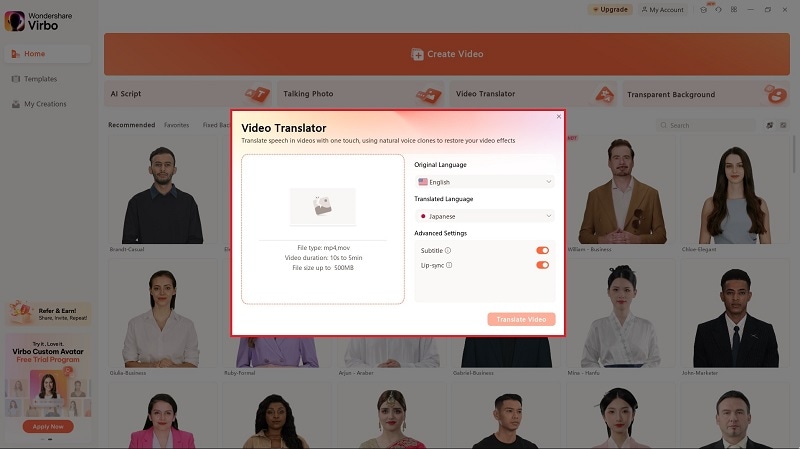
- Step 3: Wait for the translation process to complete. Once done, preview the AI-translated video to ensure accuracy and quality. If satisfied, download or export the translated video in your preferred format. Share your content afterward.

Part 3. Comparative Analysis: CapCut Translate vs. Wondershare Virbo
When considering video translation needs, several factors come into play. Here are the pros and cons of CapCut and Virbo.

CapCut Translate
CapCut Translate excels in its simplicity and affordability. Here are its pros and cons:
Pros
- · CapCut offers an easy-to-use interface.
- · You can customize subtitles from font styles, sizes, and colors.
- · CapCut auto-detects any language for easy translation.
Cons
- · CapCut doesn’t support frame rates higher than 60 fps.
- · The mobile app doesn’t support landscape mode.
Wondershare Virbo
Wondershare Virbo stands out with its advanced AI features and comprehensive language support. Here are its pros and cons:
Pros
- · Wondershare Virbo includes voice cloning and auto-script generation. It enhances translation accuracy and efficiency.
- · Virbo offers support for a wide range of languages. It ensures comprehensive coverage for diverse global audiences.
- · Virbo’s online and offline versions provide you flexibility in accessing its translation services.
Cons
- · Script generation is limited for free users.
- · Free users can only export 1 video at a time.
Pricing
Both CapCut and Virbo offer free versions. However, Virbo offers a comprehensive suite of features available on its paid plans (as of March 5, 2024):
- Monthly Plan: $9.9/month
- Yearly Plan - Essential: $19.9/year
- Yearly Plan - Pro: $199/year
The monthly plan includes 10 minutes of video credits per month. Meanwhile, the yearly essential plan provides 22 minutes per year. The annual pro plan offers 300 minutes per year. The monthly plan supports videos that are up to 2 minutes in duration. Both the annual plans allow up to 5 minutes. All plans offer a maximum resolution of 1080p and unlimited time for AI scripts.
Conclusion
CapCut Translate and Virbo offer creators valuable translation solutions. However, Virbo’s advanced AI features and language support make it a compelling choice. It’s an ideal app for users seeking top-tier translation capabilities.
The importance of selecting the right tool based on your needs cannot be overstated. It’s recommended that you test the auto-translation of CapCut and Virbo to determine the right tool for you. However, for those seeking powerful features and efficient translation, Virbo is the preferred option. Choose wisely to ensure your content reaches its full global potential**.**
Wondershare Virbo
Wondershare Virbo stands out with its advanced AI features and comprehensive language support. Here are its pros and cons:
Pros
- · Wondershare Virbo includes voice cloning and auto-script generation. It enhances translation accuracy and efficiency.
- · Virbo offers support for a wide range of languages. It ensures comprehensive coverage for diverse global audiences.
- · Virbo’s online and offline versions provide you flexibility in accessing its translation services.
Cons
- · Script generation is limited for free users.
- · Free users can only export 1 video at a time.
Pricing
Both CapCut and Virbo offer free versions. However, Virbo offers a comprehensive suite of features available on its paid plans (as of March 5, 2024):
- Monthly Plan: $9.9/month
- Yearly Plan - Essential: $19.9/year
- Yearly Plan - Pro: $199/year
The monthly plan includes 10 minutes of video credits per month. Meanwhile, the yearly essential plan provides 22 minutes per year. The annual pro plan offers 300 minutes per year. The monthly plan supports videos that are up to 2 minutes in duration. Both the annual plans allow up to 5 minutes. All plans offer a maximum resolution of 1080p and unlimited time for AI scripts.
Conclusion
CapCut Translate and Virbo offer creators valuable translation solutions. However, Virbo’s advanced AI features and language support make it a compelling choice. It’s an ideal app for users seeking top-tier translation capabilities.
The importance of selecting the right tool based on your needs cannot be overstated. It’s recommended that you test the auto-translation of CapCut and Virbo to determine the right tool for you. However, for those seeking powerful features and efficient translation, Virbo is the preferred option. Choose wisely to ensure your content reaches its full global potential**.**
Translate Video From Japanese to English Online for Free
Let’s say you’re a business owner or a content creator in Japan. If you want to broaden your horizons, you may need to translate videos from Japanese to English. This is because English is spoken globally. You can sell more, share knowledge, and connect with English speakers worldwide.
For streaming platforms, turning Japanese content into English is a ticket to reaching audiences all over the globe. And businesses using Japanese tech might need translated training videos for their remote workers.
Seeing this growing need, it’s clear you need effective video translation solutions. So, we’ve created a guide to help you choose the best method for each step, including using AI. Finding the right way to translate videos is important, so keep reading!

Part I. Completed Process To Translate Videos From Japanese to English
When you want to translate a video from Japanese to English, you can follow some general steps, no matter how you decide to do it. Let’s break down each step for you:
- Step 1: Video Transcription
Before you can translate, you need to understand what’s being said. So, the initial step is to do a video transcription. You can either hire professionals or use a Japanese-to-English video translator app to convert the spoken language to text.
Transcription captures all the Japanese dialogue, ensuring the English translation is spot-on. Having the text file lets you edit it, like shortening sentences or adjusting cultural references. This results in a smoother and more natural English video for you.
- Step 2: Translation
Once you have the transcript, you can translate the Japanese text into English. A good translation ensures the original message is accurately conveyed in the new language. It avoids any misunderstandings or misinterpretations for your English viewers. You have two options to do it. Both have strengths and weaknesses, so let’s see which suits your needs best.
- Professional Human Translation Services
When you want to translate a video from Japanese to English, a pro can make the sentences sound right for your audience. These professionals tweak the tone to be natural and engaging. If you go to translation agencies, they make sure the work is top-notch by going through strict editing and reviewing. However, human translation services cost more and take a bit more time than machine translation tools.
- Machine Translation Tools
Machine translation tools are fast and affordable. They can be a good option for short, simple videos where perfect accuracy isn’t critical. But it often struggles with complex language, cultural references, and humor.
- Step 3: Timing and Implementation
Let’s talk about making the Japanese to English video translation seamless. After translating, you want the words to match the original rhythm and pace of the speaker in the video. It keeps things feeling natural and engaging for you, the viewer. Plus, speakers use non-verbal cues like jokes, emotions, and pauses. Matching the translated text with these visual cues keeps the video’s meaning and impact intact.
How to do it? Professional workflows often use timecode, which gives each video frame a unique timestamp. It ensures super precise subtitle placement for that perfect synchronization. Some video editing tools even have “waveforms” to help visually line up subtitles with the spoken parts.

Here are several ways to add the translated Japanese text to your video:
- Subtitles
Subtitles are like on-screen translators for you. They show the English dialogue while the original Japanese audio goes on. It helps you understand if you get the visuals but not the language. The focus is on getting the main point across and sometimes making the sentences shorter for easier reading.
- Closed Captions
Like subtitles, closed captions (CC) are words shown on the screen. They go beyond spoken words, covering all the sounds you hear, like dialogue, music, and even background noises. The main goal is to help you, especially if you’re deaf or struggle with hearing. So, if you’re aiming for videos everyone can enjoy, try a video translator from Japanese to English with CC capabilities.
- Dubbing
Dubbing is a more intricate process where the original Japanese audio track is completely replaced. Voice actors step in to record the translated script in English. They try to sync up their words with the lip movements of the characters on screen. It makes it seem like the characters speak English right from the start, giving you a more immersive viewing experience.
- Voiceover
In this method, a narrator reads the translated script in English over the original Japanese audio. It’s often used in documentaries or educational videos when you need more info beyond just the dialogue.
- Step 4: Final Review and Approval
Alright, so you’re at the last step now. You’re giving the translated video a good check to ensure everything’s spot-on – accurate, consistent, and top-notch quality. It means looking out for any problems in the translation, timing, or how you choose to do it. Once you give the thumbs up to the final version, you’ve got a smooth and effective English video ready for your audience.
You might find the previous steps tedious and time-consuming. But what if you could translate your video from Japanese to English in minutes? That way, you could reach new markets and expand your influence faster. AI video translators like Wondershare Virbo can help you spread your work, passions, and stories to a global audience. Read on to learn more.
Part II. Virbo: Realistic AI Japanese to English Video Translator
You’re excited about your new product, but your explainer video feels like it’s only speaking to half the world. You know the potential exists, but the language barrier holds you back. Or perhaps you’ve captured stunning footage from your recent trip to Kyoto, but sharing it with your followers feels like a lost cause.
Here’s the deal: you don’t have to stick to a small crowd.

Get Started Online Free Download
Virbo uses the latest AI tech to automatically translate, dub voice, and add synced subtitles to your Japanese video. This app is simple to use and can translate video content into over 20 languages. Virbo translates Japanese to English videos in a few minutes – all free for videos under 2 minutes!
Here’s what makes Virbo stand out:
- Precise Lip-sync: Say goodbye to awkward, out-of-sync translations. Virbo AI video translator ensures the translated dialogue seamlessly matches the speaker’s lip movements and facial expressions, creating a natural and engaging experience (still in beta, but getting better every day!).
- AI Cloning Voices: Add engagement with Virbo’s AI-cloned voices that capture the essence of human speech. Choose from a range of natural-sounding voices that express the right emotions and add personality to your content.
- Soundtrack Reserved: Don’t lose the original soundtrack that sets the mood. Virbo allows you to keep it intact, enhancing its impact even in different languages.
- Versatile Compatibility: Virbo works across various platforms, including Windows, iOS, and Android. You can even use it online for ultimate flexibility.
- Affordable Excellence: Experience the power of AI video translation without breaking the bank. Virbo offers high-quality solutions at affordable prices, making them accessible to everyone.
Part III. How To Translate Japanese to English Video Using Virbo Automatically
Using Virbo AI video translator can help you be more productive. Here’s how to translate a video in Japanese to English online for free:
- Step 1: Go to Virbo AI video translator online from your browser for quick access. You can also download the app for your desktop. Once you’ve chosen your access point, sign in using your existing Google, Facebook, email, Apple, or Twitter account.
Get Started Online Free Download
- Step 2: Choose and upload your Japanese video file from your local storage. Ensure the video is between 10 seconds to 5 minutes long and in MP4 or MOV format, up to 500 MB for optimal processing.
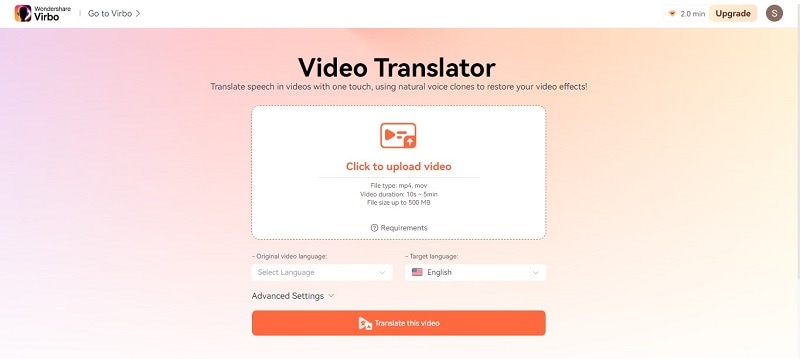
- Step 3: Specify Japanese as the Original video language and English as the desired Target language.
- Step 4: Virbo offers Advanced Settings to customize the translated view result. Toggle on the Lip-sync, Subtitle, and Proofread video script switches to enable them when needed.
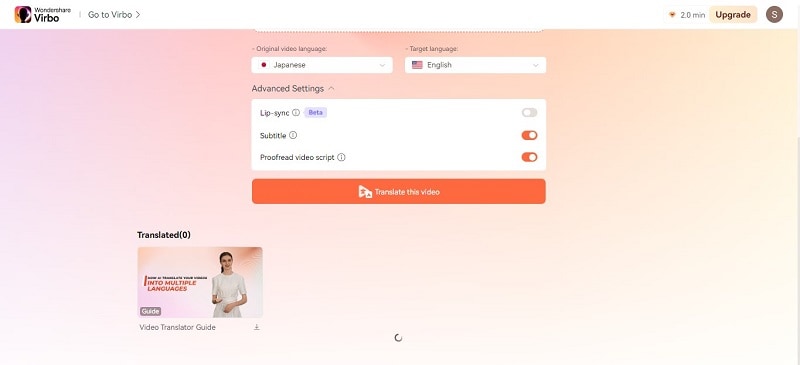
- Step 5: Click Translate this video to start the translation process once everything is set.
- Step 6: Wait a few moments while Virbo performs video transcription. Review the text and edit if needed.
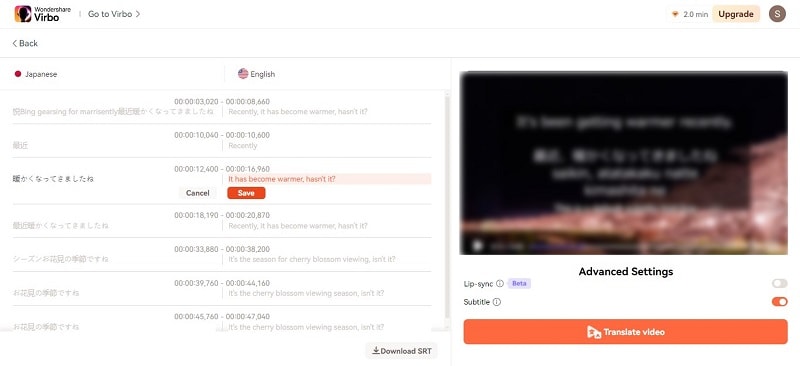
- Step 7: Click Translate video to proceed, then the video will go to the queue.
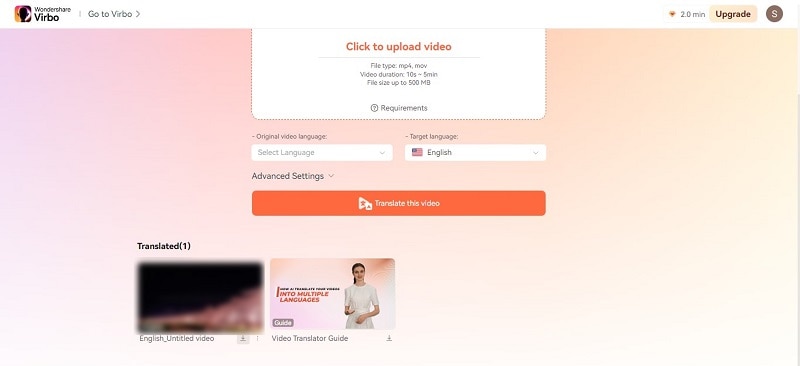
- Step 8: After completion, you can preview the translated video before downloading the final English version.
Part IV. How To Achieve the Best Video Translation Results?
You can’t always translate a video from Japanese to English without a few difficulties. Here are some ways to make the process easier for you:
Divide the Script Into Manageable Chunks
Break down the script into smaller sections like sentences, phrases, or even shorter segments depending on the video’s pace and complexity. It allows for more precise timing adjustments later.
Use a “Shadowing” Technique
As you watch the video, read the translated text out loud. Adjust the subtitle timing to match how you naturally speak. Doing this makes the flow feel more natural for you and the viewers.
Test and Refine
Now that you’ve set the timing for the subtitles, it’s time to put them to the test with your target audience. This step is important because it helps you catch any timing problems, awkward phrasing, or cultural differences that might have slipped through during editing.
Listen to what your audience says, and then use that feedback to tweak the subtitles. Your goal is to make sure they’re clear, short, and match the audience’s culture.
AI for Pre-Translation Tasks
Take advantage of AI tools for speech-to-text conversion and automatic subtitle generation. It can save time, but always proofread for accuracy and natural flow.
File Compatibility
Ensure your chosen translation service or tool supports the format of your video file. The common formats include MP4, MOV, and AVI.
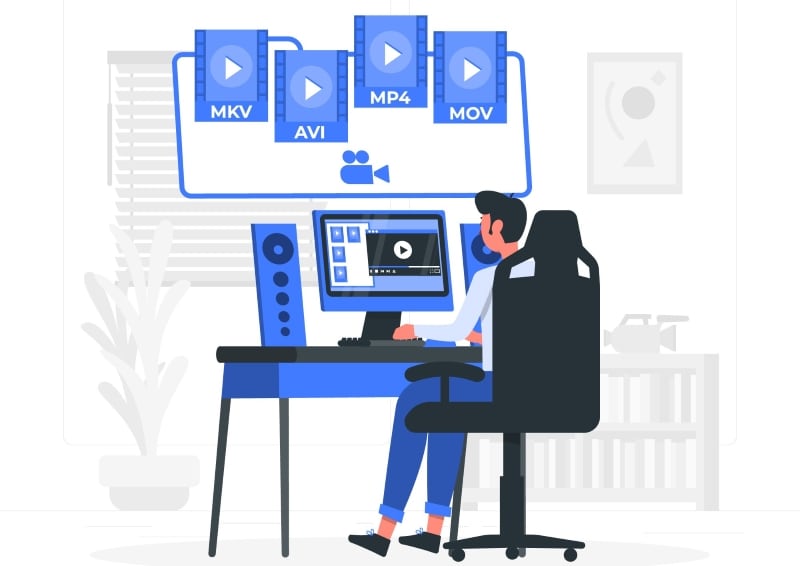
Conclusion
So you’ve seen how easy it can be to translate a video from Japanese to English. It’s up to you whether you will ask for the help of human translators, video editors, or AI video translators.
As you know, Virbo goes beyond being a basic Japanese to English video translator and converter. It takes the complexity out of translation, offering seamless and accurate results.
But remember, even the best AI translation can benefit from a human touch. Don’t be afraid to experiment and refine your translated video for the best outcome. With a little effort, you can bridge the language barrier and share your Japanese video content with the world.
Elevate Your Content with the Best Free Video Translator Apps
Welcome to the world of content creation, where language should never be a barrier to connecting with your audience. In a world that thrives on diversity, the key to expanding your reach lies in breaking down linguistic barriers. This journey begins with harnessing the capabilities of the best free video translator apps. In this article, we delve into free video language translator apps catering to various needs, and pave the way for a more inclusive and globally connected audience.
Part 1: How Do Video Translator Apps Work?
Many free video translator apps are available today to help convey your message in different languages. These apps often act like magic tricks to assist people in understanding videos all over the world. For understanding its operation, it starts with speech recognition which is listened by the translation app. The words that are being said in the video are converted into text.
The app then utilizes machine translation powered by AI. This technology translates the text transcript from the source to your target language. As it reaches the end, the translated text appears as subtitles on the screen. You can follow the video and understand the content presented in it, even if it is not present in the native language.
Part 2: Benefits of Translating Video Through Best Video Translator
In the vast landscape of digital content, the ability to transcend language barriers is a powerful asset for content creators. This part of our exploration dives into the manifold benefits of translating videos through the best video translator apps, emphasizing how this strategic move can profoundly impact your reach and engagement.
1. Expanding Your Audience Reach
One of the primary advantages of leveraging the best video translator app free is the unparalleled ability to broaden your audience spectrum. By breaking language barriers, your content becomes accessible to viewers around the globe, fostering a diverse and engaged community.
2. Improving Engagement and Retention
A YouTube video translator app isn’t merely a tool for language conversion; it’s a catalyst for enhanced viewer engagement. Subtitles or voiceovers in a viewer’s native language not only make your content more comprehensible but also contribute to increased viewer retention, as audiences are more likely to invest time in content they can effortlessly understand.
3. Enhancing Accessibility
Beyond linguistic inclusivity, utilizing a free video translator app ensures your content is accessible to a wider audience, including those with hearing impairments. This commitment to accessibility strengthens your content’s appeal and contributes to the creation of a more inclusive online space.
4. Boosting SEO and Discoverability
The advantages of a video subtitle translator app extend beyond immediate viewer experience. Translating your video content can significantly boost its search engine optimization (SEO), making it more discoverable to users searching for content in various languages. This increased visibility can amplify your content’s impact across diverse platforms.
5. Facilitating Cross-Cultural Communication
A video voice translator app isn’t just a technological tool; it’s a bridge for effective cross-cultural communication. Breaking down language barriers fosters a sense of connection and understanding, creating a more engaged and loyal audience base that spans across different cultural backgrounds.
Part 3: Free Video Translator Apps to Translate Every Type of Video
In this section, we set forth on an exploration of the vast landscape of free video voice language translator apps. Our aim is to unveil a myriad of tools, each uniquely designed to cater to a spectrum of video translation needs. Join us as we navigate this diverse terrain, discovering the ideal solutions for every type of video translation requirement.
1. Wondershare Virbo
In the fast-paced world of digital content creation, the ability to communicate with a global audience is a game-changer. Virbo, a cutting-edge video language translator app, steps into this arena, offering content creators a dynamic platform to transcend linguistic barriers and connect with viewers worldwide. As we delve into Virbo, let’s explore its unique features, advantages, and considerations. It is readily available on both the Google Play Store and iOS App Store, ensuring accessibility for content creators across different platforms.
Get Started Online Download APP Now Free Download
Features:
- Whether you’re a seasoned creator or just starting, it’s user-friendly layout ensures a smooth and efficient experience.
- Its advanced speech recognition ensures accurate and nuanced translations, enhancing the audiovisual appeal of your content.
- It ensures that you can translate content dynamically as you create, providing instant feedback on how your video will resonate with a global audience.
Pros
- Its intuitive design ensures that creators of all levels can navigate the app seamlessly.
- Its extensive range of supported languages makes it a versatile tool for connecting with diverse audiences.
- Its commitment to user privacy ensures a secure environment for content creation and translation.
Cons
- It offers an offline mode; some features may be limited without an internet connection.
- For new users, the array of features may require some learning, but the intuitive design helps mitigate this.
How to Use Wondershare Virbo to Translate Videos
Wondershare Virbo makes it easy for users to translate their videos into any language, making the content accessible to a broader audience. Here is a quick guide on how to use this best video translator app to your advantage:
Step 1. Launch AI Video Translator on Virbo
To start translating your video using Virbo, install the app on your iOS or Android device. Once you launch Virbo on your smartphone, you must register using your Google or Apple ID. Choose a suitable option or use “Guest Login” from the top-right corner to continue without an ID. Next, launch the app and choose the “AI Video Translator” button from the homepage.

Step 2. Insert Video for Translation
You can follow the prompts present on the screen to upload your files. Keep in mind that the video resolution must be between 480x480 and 1920x1920. Virbo can only translate human voiceovers and cannot translate music or songs in the video, so files with background audio should be avoided.

Step 3. Specify Parameters and Translate Video
On the next window, select the original language of your video and the target language for translation. Virbo allows users to choose from multiple accents and voices. You can also tweak other options, such as keeping the subtitles after translation or keeping the original background music. Tap the “Translate” button, and once your video is generated, use the “Export” option to save it to your device.

Get Started Online Download APP Now Free Download
2. Google Translate
Standing as a beacon of versatility, Google Translate emerges as a leading video audio translator app. It supports a multitude of languages. It goes beyond traditional translation methods, offering real-time translation through the camera. Whether your content is spoken or written, it provides a user-friendly solution for diverse video translation requirements. Available on both Google Play Store and iOS, it ensures accessibility across different platforms, making it a convenient choice for users on various devices.

Features:
- It boasts an extensive language repertoire, supporting a vast array of languages, making it a versatile tool for global content translation.
- It excels in translating written text. Its text translation capabilities are robust and cover a wide range of linguistic nuances.
- A standout feature is the real-time camera translation, enabling users to translate text in images or videos instantly through their device’s camera.
Pros
- It has a user-friendly interface, making it accessible for users with varying levels of technological expertise.
- It eliminates financial barriers, allowing a broad user base to benefit from its language translation features.
- It regularly updates and improves its translation algorithms.
Cons
- It may still face challenges in accurately translating complex or context-specific phrases.
- Its certain features depend on an internet connection, limiting functionality in offline scenarios.
3. Microsoft Translator
In the world of text and voice translation, Microsoft Translator takes the spotlight. This free and accessible tool caters to content creators seeking seamless translation for spoken content in their videos. Its user-friendly interface and wide language support make it a go-to choice for creators of all levels. Available on both Google Play Store and iOS, Microsoft Translator offers a versatile solution for on-the-go translation needs.

Features:
- It boasts an extensive language portfolio, covering a diverse range of languages to facilitate global communication.
- It excels in text and voice translations, providing users with flexibility in how they choose to communicate across language barriers.
- It is designed with a user-friendly interface, ensuring accessibility for users with varying levels of technical expertise.
Pros
- It is recognized for its accurate speech recognition.
- It allows users to translate content directly within familiar Office tools.
- It supports collaborative translation efforts, enabling multiple users to work together on translating content.
Cons
- It may face challenges in achieving the same level of fluency and nuance in translations for all supported languages.
- Some advanced features may depend on a consistent internet connection.
4. SayHi
Venturing into the realm of voice translation, SayHi captures attention with its real-time translation capabilities. Ideal for creators looking for video voice translator app to add voiceovers or dubbing in different languages, it provides a seamless experience for translating spoken words, enriching the audiovisual dimension of your videos. Find it on iOS and Google Play Store for an accessible and versatile translation experience.

Features:
- It specializes in real-time voice translation, allowing users to engage in live conversations and create dynamic multilingual content effortlessly.
- It supports a wide array of languages, enabling users to translate spoken words seamlessly across diverse linguistic contexts.
- It features a user-friendly interface, making it accessible for users of various language proficiency levels and technical expertise.
Pros
- It offers an offline mode, allowing users to download language packs and perform translations without the need for a continuous internet connection.
- It includes a phrasebook feature, enabling users to store commonly used phrases for quick and easy access during conversations.
- Users have the ability to define and customize dialects, enhancing the precision of translations for specific regional or contextual language nuances.
Cons
- It may face challenges in accurately capturing the nuanced complexities of certain languages and dialects.
- Some advanced features may depend on an internet connection, limiting functionality in offline scenarios.
5. iTranslate Converse
iTranslate Converse takes real-time translation to a new level with its intuitive design resembling a messaging app. This innovative approach allows users to engage in natural conversations that are instantly translated. Supporting a plethora of languages, it is a dynamic tool for spontaneous communication, making it a go-to for those seeking seamless interaction. Available on iOS and the Google App Store, it’s the go-to choice for seamless, spontaneous communication.

Features:
- It resembles a messaging app, offering a familiar and user-friendly environment for communication.
- It facilitates natural and fluid conversations with instant translation, enhancing the user experience.
- This app goes beyond text, allowing users to send voice messages that are instantly translated, adding a dynamic and personal touch to conversations.
Pros
- It excels in real-time conversation mode, allowing users to communicate naturally without interruptions.
- The app’s design enhances usability.
- Ideal for spontaneous communication.
Cons
- Some advanced features may require a subscription.
- Like many translation apps, accuracy may be influenced by speech clarity and ambient noise.
6. Papago
Hailing from South Korea, Papago is an acclaimed translation app known for its accuracy and efficiency. Available on the Google App Store, it provides real-time text and voice translation, breaking down language barriers in everyday and business settings. Papago’s commitment to precision makes it a reliable companion for seamless global communication.

Features:
- It accurately captures spoken language and converts it into text, providing users with a seamless and efficient way to communicate across language barriers.
- It is known for its accuracy and efficiency in translating both text and voice.
- It provides a comprehensive range of supported languages, catering to diverse user needs.
Pros
- It incorporates human expertise, adding a nuanced touch to translations that go beyond literal meaning.
- It brings a unique perspective and precision to its translations.
- It offers offline functionality.
Cons
- It may be less known globally compared to some other translation apps.
- The interface may be perceived as more complex for users seeking a simpler design.
Bonus Part. FAQs About Video Translator Apps
- Can free video translator apps be used offline?
While many video translator apps are available today, only a few free apps can work offline. Some free options claim offline video translation, but their accuracy and functionalities might be restricted. Unlike the more comprehensive online selection, free versions may restrict offline translation to a few popular languages. In addition, real-time translation of live videos often requires an internet connection to process them.
- Can free video translator apps handle all types of videos?
Free video translator apps can usually handle a good variety of videos. However, a few limitations may arise at times. Most free apps will likely work with popular video formats like MP4, and some might support fewer common formats. Similarly, free apps may have restrictions on video lengths. They may also struggle with videos with heavy background noise or multiple speakers.
- Are free video translator apps accurate?
The accuracy of free video translator apps is a mixed bag. Usually, accuracy factors depend on the machine-learning abilities of individual apps. Free apps can translate basic sentences with clear audio reasonably well. You can likely grasp the overall idea of a video in a common language with a free translator app.
- How do you translate a video into English?
You can try one of the many video translator apps available today to translate a video into English. In all honesty, the most reliable tool for video translation is Wondershare Virbo. It has all the tools you may need to convert a language into English. Virbo is a quick and easy way to accurately translate videos to and from any language in a few clicks.
Get Started Online Download APP Now Free Download
Conclusion
In the world of digital content creation, breaking language barriers is the key to global engagement. Video translation apps serve as invaluable tools for content creators, enabling them to connect with diverse audiences. From exploring the benefits of the best video translator app to introducing free options like Wondershare Virbo, Google Translate, Microsoft Translator, Subtitle Edit, SayHi, and Amara, this journey has showcased the vast landscape of possibilities.
Get Started Online Download APP Now Free Download
Features:
- Whether you’re a seasoned creator or just starting, it’s user-friendly layout ensures a smooth and efficient experience.
- Its advanced speech recognition ensures accurate and nuanced translations, enhancing the audiovisual appeal of your content.
- It ensures that you can translate content dynamically as you create, providing instant feedback on how your video will resonate with a global audience.
Pros
- Its intuitive design ensures that creators of all levels can navigate the app seamlessly.
- Its extensive range of supported languages makes it a versatile tool for connecting with diverse audiences.
- Its commitment to user privacy ensures a secure environment for content creation and translation.
Cons
- It offers an offline mode; some features may be limited without an internet connection.
- For new users, the array of features may require some learning, but the intuitive design helps mitigate this.
How to Use Wondershare Virbo to Translate Videos
Wondershare Virbo makes it easy for users to translate their videos into any language, making the content accessible to a broader audience. Here is a quick guide on how to use this best video translator app to your advantage:
Step 1. Launch AI Video Translator on Virbo
To start translating your video using Virbo, install the app on your iOS or Android device. Once you launch Virbo on your smartphone, you must register using your Google or Apple ID. Choose a suitable option or use “Guest Login” from the top-right corner to continue without an ID. Next, launch the app and choose the “AI Video Translator” button from the homepage.

Step 2. Insert Video for Translation
You can follow the prompts present on the screen to upload your files. Keep in mind that the video resolution must be between 480x480 and 1920x1920. Virbo can only translate human voiceovers and cannot translate music or songs in the video, so files with background audio should be avoided.

Step 3. Specify Parameters and Translate Video
On the next window, select the original language of your video and the target language for translation. Virbo allows users to choose from multiple accents and voices. You can also tweak other options, such as keeping the subtitles after translation or keeping the original background music. Tap the “Translate” button, and once your video is generated, use the “Export” option to save it to your device.

Get Started Online Download APP Now Free Download
2. Google Translate
Standing as a beacon of versatility, Google Translate emerges as a leading video audio translator app. It supports a multitude of languages. It goes beyond traditional translation methods, offering real-time translation through the camera. Whether your content is spoken or written, it provides a user-friendly solution for diverse video translation requirements. Available on both Google Play Store and iOS, it ensures accessibility across different platforms, making it a convenient choice for users on various devices.

Features:
- It boasts an extensive language repertoire, supporting a vast array of languages, making it a versatile tool for global content translation.
- It excels in translating written text. Its text translation capabilities are robust and cover a wide range of linguistic nuances.
- A standout feature is the real-time camera translation, enabling users to translate text in images or videos instantly through their device’s camera.
Pros
- It has a user-friendly interface, making it accessible for users with varying levels of technological expertise.
- It eliminates financial barriers, allowing a broad user base to benefit from its language translation features.
- It regularly updates and improves its translation algorithms.
Cons
- It may still face challenges in accurately translating complex or context-specific phrases.
- Its certain features depend on an internet connection, limiting functionality in offline scenarios.
3. Microsoft Translator
In the world of text and voice translation, Microsoft Translator takes the spotlight. This free and accessible tool caters to content creators seeking seamless translation for spoken content in their videos. Its user-friendly interface and wide language support make it a go-to choice for creators of all levels. Available on both Google Play Store and iOS, Microsoft Translator offers a versatile solution for on-the-go translation needs.

Features:
- It boasts an extensive language portfolio, covering a diverse range of languages to facilitate global communication.
- It excels in text and voice translations, providing users with flexibility in how they choose to communicate across language barriers.
- It is designed with a user-friendly interface, ensuring accessibility for users with varying levels of technical expertise.
Pros
- It is recognized for its accurate speech recognition.
- It allows users to translate content directly within familiar Office tools.
- It supports collaborative translation efforts, enabling multiple users to work together on translating content.
Cons
- It may face challenges in achieving the same level of fluency and nuance in translations for all supported languages.
- Some advanced features may depend on a consistent internet connection.
4. SayHi
Venturing into the realm of voice translation, SayHi captures attention with its real-time translation capabilities. Ideal for creators looking for video voice translator app to add voiceovers or dubbing in different languages, it provides a seamless experience for translating spoken words, enriching the audiovisual dimension of your videos. Find it on iOS and Google Play Store for an accessible and versatile translation experience.

Features:
- It specializes in real-time voice translation, allowing users to engage in live conversations and create dynamic multilingual content effortlessly.
- It supports a wide array of languages, enabling users to translate spoken words seamlessly across diverse linguistic contexts.
- It features a user-friendly interface, making it accessible for users of various language proficiency levels and technical expertise.
Pros
- It offers an offline mode, allowing users to download language packs and perform translations without the need for a continuous internet connection.
- It includes a phrasebook feature, enabling users to store commonly used phrases for quick and easy access during conversations.
- Users have the ability to define and customize dialects, enhancing the precision of translations for specific regional or contextual language nuances.
Cons
- It may face challenges in accurately capturing the nuanced complexities of certain languages and dialects.
- Some advanced features may depend on an internet connection, limiting functionality in offline scenarios.
5. iTranslate Converse
iTranslate Converse takes real-time translation to a new level with its intuitive design resembling a messaging app. This innovative approach allows users to engage in natural conversations that are instantly translated. Supporting a plethora of languages, it is a dynamic tool for spontaneous communication, making it a go-to for those seeking seamless interaction. Available on iOS and the Google App Store, it’s the go-to choice for seamless, spontaneous communication.

Features:
- It resembles a messaging app, offering a familiar and user-friendly environment for communication.
- It facilitates natural and fluid conversations with instant translation, enhancing the user experience.
- This app goes beyond text, allowing users to send voice messages that are instantly translated, adding a dynamic and personal touch to conversations.
Pros
- It excels in real-time conversation mode, allowing users to communicate naturally without interruptions.
- The app’s design enhances usability.
- Ideal for spontaneous communication.
Cons
- Some advanced features may require a subscription.
- Like many translation apps, accuracy may be influenced by speech clarity and ambient noise.
6. Papago
Hailing from South Korea, Papago is an acclaimed translation app known for its accuracy and efficiency. Available on the Google App Store, it provides real-time text and voice translation, breaking down language barriers in everyday and business settings. Papago’s commitment to precision makes it a reliable companion for seamless global communication.

Features:
- It accurately captures spoken language and converts it into text, providing users with a seamless and efficient way to communicate across language barriers.
- It is known for its accuracy and efficiency in translating both text and voice.
- It provides a comprehensive range of supported languages, catering to diverse user needs.
Pros
- It incorporates human expertise, adding a nuanced touch to translations that go beyond literal meaning.
- It brings a unique perspective and precision to its translations.
- It offers offline functionality.
Cons
- It may be less known globally compared to some other translation apps.
- The interface may be perceived as more complex for users seeking a simpler design.
Bonus Part. FAQs About Video Translator Apps
- Can free video translator apps be used offline?
While many video translator apps are available today, only a few free apps can work offline. Some free options claim offline video translation, but their accuracy and functionalities might be restricted. Unlike the more comprehensive online selection, free versions may restrict offline translation to a few popular languages. In addition, real-time translation of live videos often requires an internet connection to process them.
- Can free video translator apps handle all types of videos?
Free video translator apps can usually handle a good variety of videos. However, a few limitations may arise at times. Most free apps will likely work with popular video formats like MP4, and some might support fewer common formats. Similarly, free apps may have restrictions on video lengths. They may also struggle with videos with heavy background noise or multiple speakers.
- Are free video translator apps accurate?
The accuracy of free video translator apps is a mixed bag. Usually, accuracy factors depend on the machine-learning abilities of individual apps. Free apps can translate basic sentences with clear audio reasonably well. You can likely grasp the overall idea of a video in a common language with a free translator app.
- How do you translate a video into English?
You can try one of the many video translator apps available today to translate a video into English. In all honesty, the most reliable tool for video translation is Wondershare Virbo. It has all the tools you may need to convert a language into English. Virbo is a quick and easy way to accurately translate videos to and from any language in a few clicks.
Get Started Online Download APP Now Free Download
Conclusion
In the world of digital content creation, breaking language barriers is the key to global engagement. Video translation apps serve as invaluable tools for content creators, enabling them to connect with diverse audiences. From exploring the benefits of the best video translator app to introducing free options like Wondershare Virbo, Google Translate, Microsoft Translator, Subtitle Edit, SayHi, and Amara, this journey has showcased the vast landscape of possibilities.
Get Started Online Download APP Now Free Download
Create Lip Sync TikTok Videos Without Installing Any App
TikTok has transformed the social media landscape through its short-form video content. They encourage users to make creative content using popular audio clips. Which enables them to entertain, gain recognition, and contribute to the platform.
Lip-syncing is a big part of what makes TikTok popular. Many users post lip-syncing videos that imitate voices from songs, movies, or trending audio clips. This art of lip-syncing has become an essential element of TikTok’s culture. Now, you might wonder how to lip-sync on TikTok videos. This article will teach us how to make it effortlessly.
Part 1. Why Do People Lip Sync on TikTok?
Lip-syncing involves mimicking the words or vocals of an existing audio track. TikTok users take this concept to new heights by lip-syncing popular songs or clips. Lip-sync is appealing because it lets people get creative and reach a large audience.
Here are a few reasons why people engage in lip sync TikTok:
- Self-expression: Lip-sync allows users to embody their favorite artists or characters by showcasing their personality and creativity.
- Entertainment: Many users lip-sync to entertain followers. They offer comedic performances, heartfelt renditions, or engaging storytelling.
- Virality: TikTok’s algorithm favors engaging content and well-executed lip-sync videos. They have the potential to go viral, rapidly gaining likes, shares, and followers.
Part 2. How to Make Lip Sync Video on TikTok
Here’s the step-by-step guide on how to lip sync on TikTok and captive your followers:
- Step 1. Open the TikTok app and tap the “+” button.
Start with opening the TikTok app on your phone. Then, tap the “+” button at the bottom of your screen to make a new video.
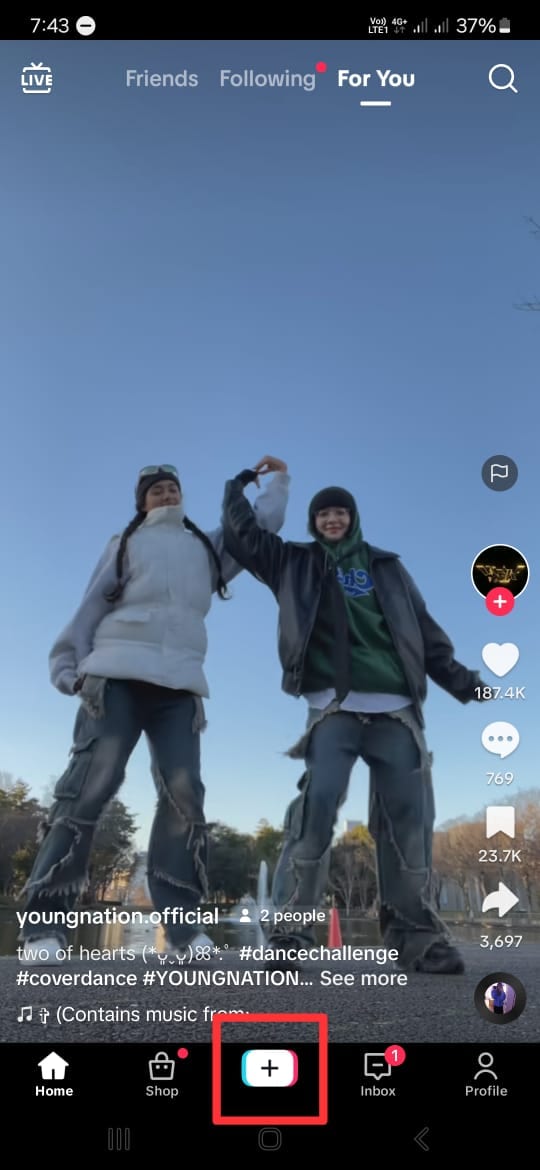
- Step 2. Add a song that you want to lip-sync to.
Next, click “Add Sound” with the musical note icon at the top of the screen. If you have a specific song in mind, you can find it by searching it on the search tab. Then, tap the song and click the check icon beside it.
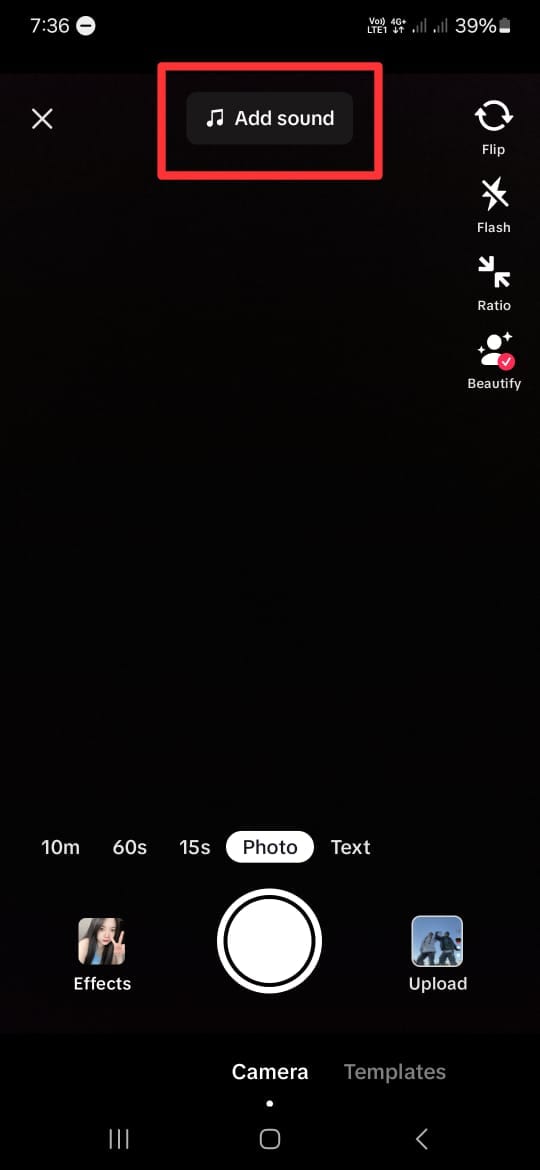
- Step 3. Choose the duration and the part of the song.
After choosing the song you want, you will return to the recording screen. Here, select your video duration at the bottom of the screen. You can choose between 10 minutes, 60 seconds, and 15 seconds. Remember that the duration of the songs on TikTok is usually only 30 to 60 seconds.
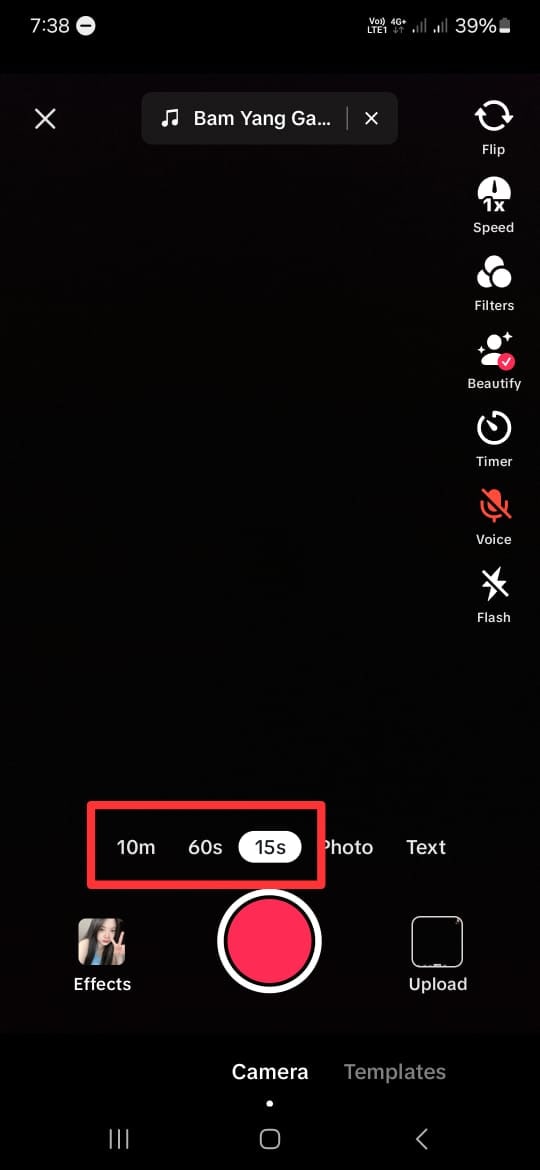
- Step 4. Choose the part of the song.
TikTok allows you to change the part of the song when lip-sync. However, the duration of the video should be less than the duration of the chosen song.
To do this, click on the song’s name at the top of your screen. Then, the bottom of your screen will display your chosen song. Tap the scissor icon and slide the playback to change the part of the song. Click “Done” once you have finished editing.

- Step 5. Tap on the red button.
If you are ready to record, tap the red button at the bottom of your screen. Then TikTok will play the chosen part of the song and record your lip-sync simultaneously. You can pause and continue the recording by clicking the same red button.
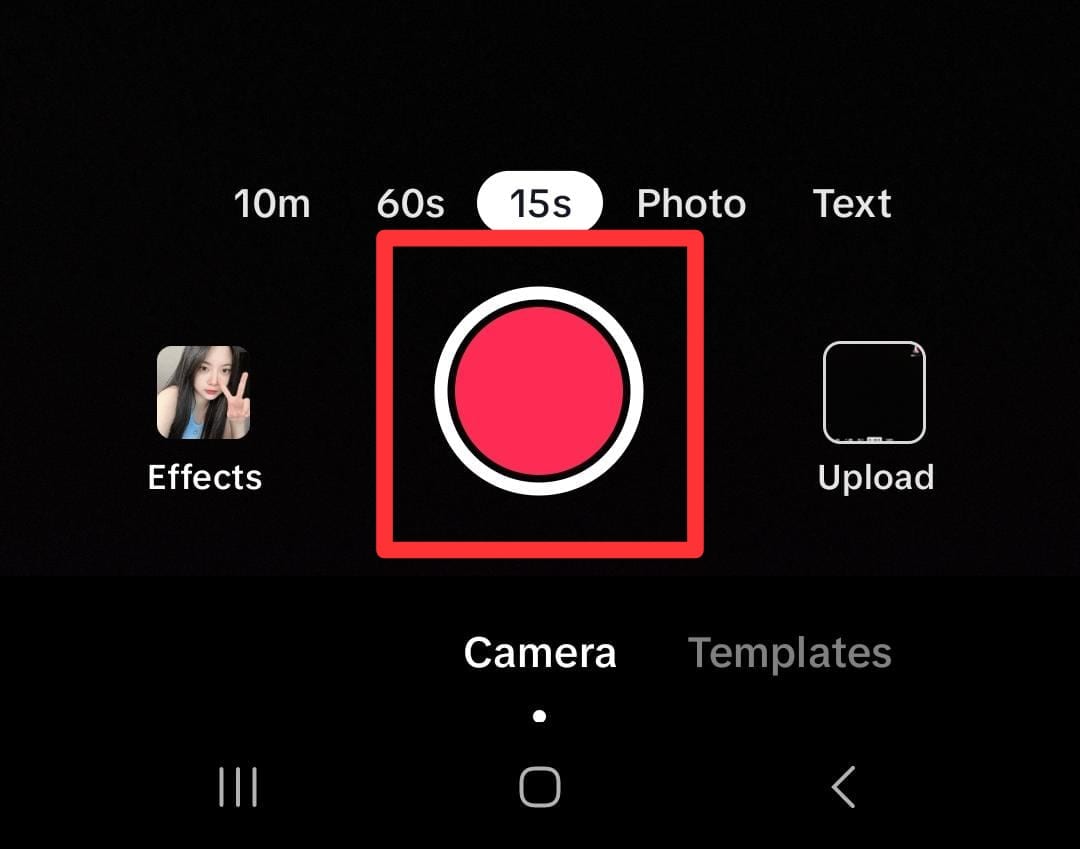
- Step 6. Post the video.
If you are satisfied with the results of your edits, click Next to proceed to the posting stage. Here, you can write a description and any other information you want. Click Post to share your lip-sync video to TikTok.

Creating a video on TikTok by lip-syncing is a fun and creative way to express yourself and connect with others. By following the steps above, you can create a lip-sync video on the TikTok app with ease. Keep in mind that by using these steps, you need to memorize the sentences and understand the beat of the chosen songs.
Part 3. How to Make Lip Sync Video Without Memorizing the Words
Making a TikTok lip-sync video can be challenging because you must remember and match the words with the music. But there are three simple methods to make it easier.
Method 1: Record at slower speed
You can slow the speed down while recording instead of trying to keep up with the song. This technique lets you hear, understand, and follow the words more easily.
Here’s how to slow down the recording:
- Step 1. Follow steps 1 to 4 from the step-by-step guide in Part 2.
Start by following the first to fourth steps from the guide in Part 2 above.
- Step 2. Set the speed record slower.
On the recording screen, click on the Speed icon on the right side of the screen. To make it slower, choose 2x or 3x. This step will make your recording time 2 or 3 times longer than it should be.
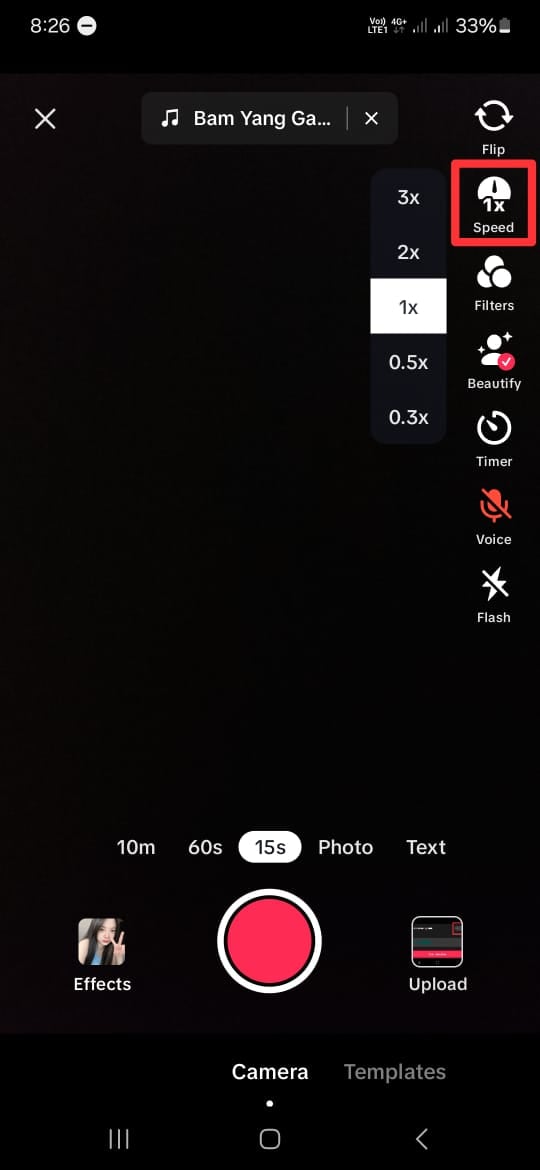
- Step 3. Tap on the red button.
Once you tap the red button, TikTok will play the song slower and record your lip-sync simultaneously. Repeat this step to help you memorize the lyrics and the beat of the songs.
Once you’re comfortable, switch back to normal speed for the final recording. This method will save time and improve accuracy.
Method 2: Purposely delay mouthing the words
While lip-syncing videos may vary in style and pacing, this technique can prove particularly useful for slower rhythms. Moreover, mastering the art of mouth sync on TikTok can elevate the overall production value of lip-syncing videos.
Using the timer feature will give you a slight lag between lip movements and audio playback. Then, it lets creators ensure more precise synchronization during editing. Here’s how to lip-sync on TikTok more easily:
- Step 1. Follow steps 1 to step 4 from the step-by-step guide in Part 2.
Like Method 1, you can start by following the first to fourth steps from the guide in Part 2 above.
- Step 2. Delay the recording
On the recording screen, click on the Timer icon on the right side of the screen. Here, you can set the timer to 3 to 10 seconds to delay the recording’s start. You can also drag and set the recording limit if you want.
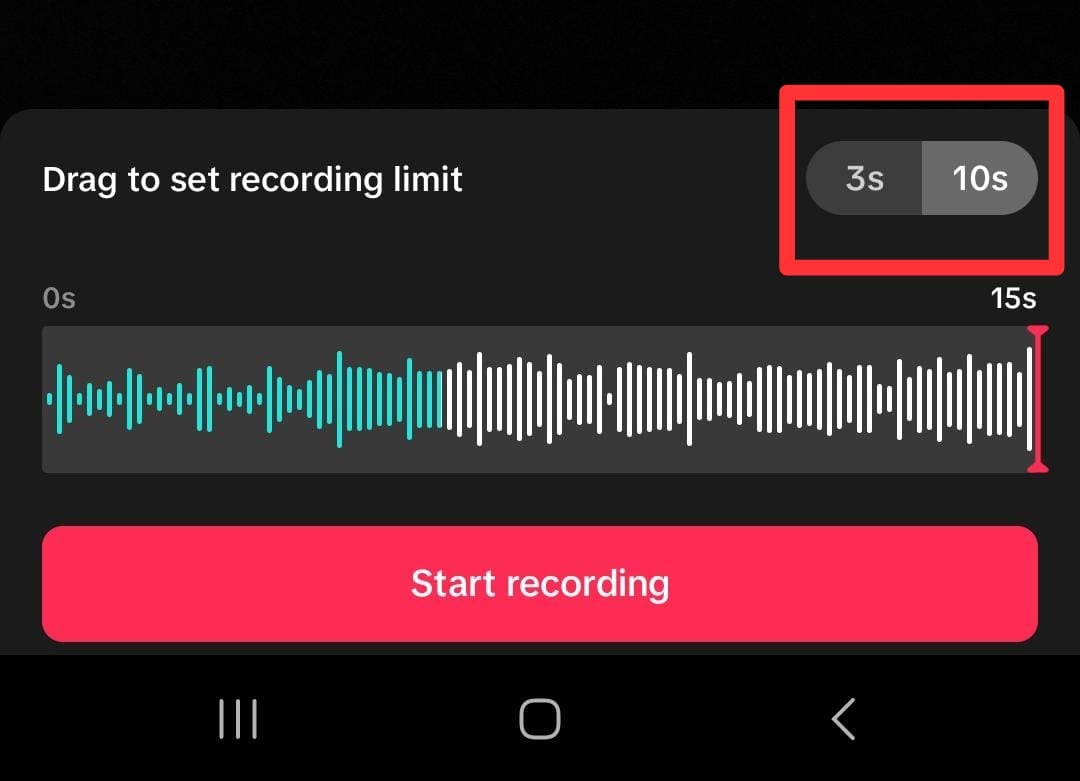
- Step 3. Start the recording
Then click “Start recording” to record the video with the timer on.
Method 3: Use a Photo Talking Tool
Next, consider using a Talking Photo feature by Wondershare Virbo. This method is for you who want to create engaging TikTok lip-sync videos without memorizing the words.
Virbo’s Talking Photo feature tool lets you upload a portrait of your photo and then make it appear as though it is speaking along with the audio. You do not have to install the app because you can use this feature online on their official website.
Here’s how to use Wondershare Virbo - Photo Talking feature to create a TikTok lip-sync video:
- Step 1. Start a new project.
Open the Wondershare Virbo website and tap the talking photo function to start a new project.
Get Started Online Free Download
- Step 2. Upload a portrait.
Tap “Upload Photo”, then upload a picture you want to use by following the instructions.
- Step 3. Edit and export.
Insert the text and adjust the voice settings. If you want to insert your own audio, you can use Wondershare Virbo for mobile or Desktop to upload or record your audio. Then, tap “Generate Video” to export.
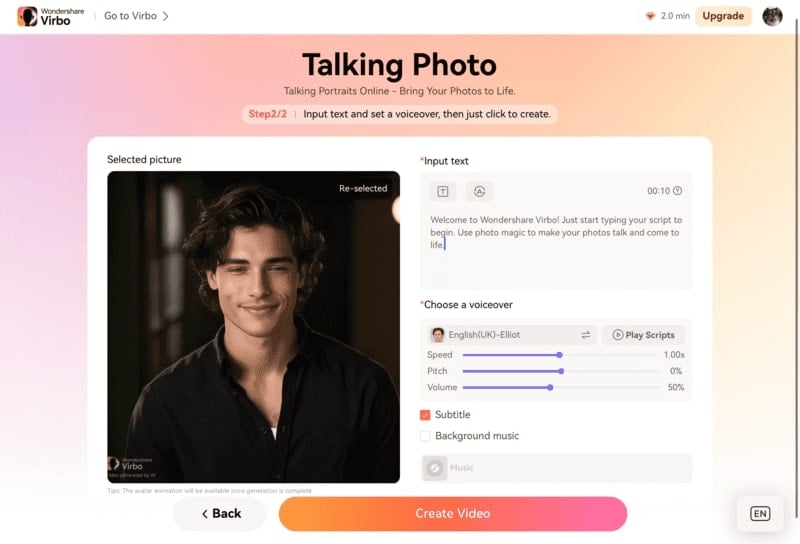
Now, you have successfully made your own TikTok lip-sync video. You can upload it to TikTok and share it with your followers. For more detailed instructions, you can see how to use Virbo’s Photo Talking tool.
Part 4: How To Lipsync Your Video to Any Language Using AI Video Translator
In today’s globalized world, reaching audiences in different languages is important for effective communication. Thanks to technological advancements, there is a tool that can help you translate video content.
Wondershare Virbo – Video Translator offers seamless solutions to translate video content into various languages with AI. Virbo ensures high-quality translations that maintain the integrity and impact of your original message.
How to lipsync TikTok videos to any language with Wondershare Virbo - Video Translator:
- Step 1. Go to Virbo’s official website, then click Generate AI Video Online.

Get Started Online Free Download
- Step 2. Log in or create an account.
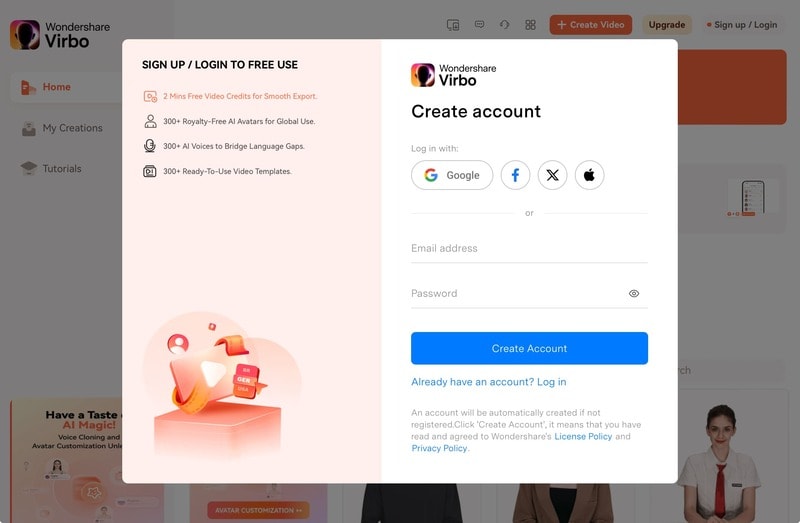
- Step 3. Then, navigate to the Video Translator tool on the Virbo’s homepage.
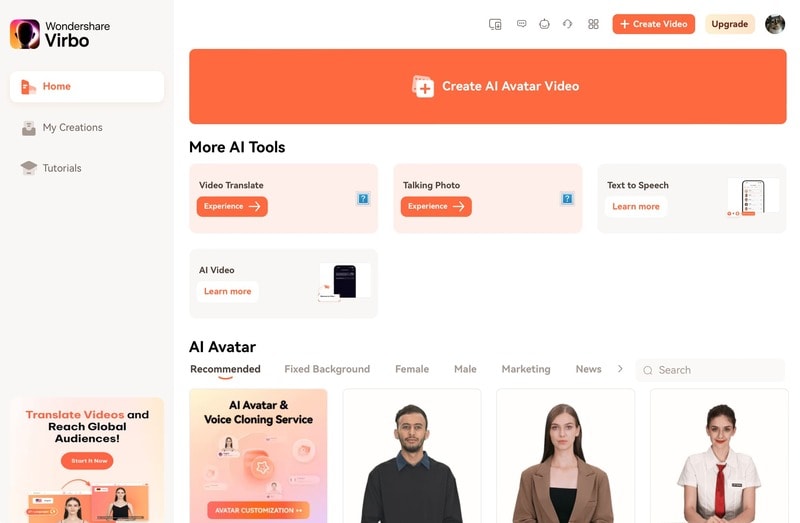
- Step 4. Upload the video.
Once inside the Video Translator interface, upload the video file you wish to translate. Select the original video language and the preferred target language from the available options. Additionally, enable the Lip Sync feature to ensure that the translated audio aligns perfectly with the lip movements in the video.
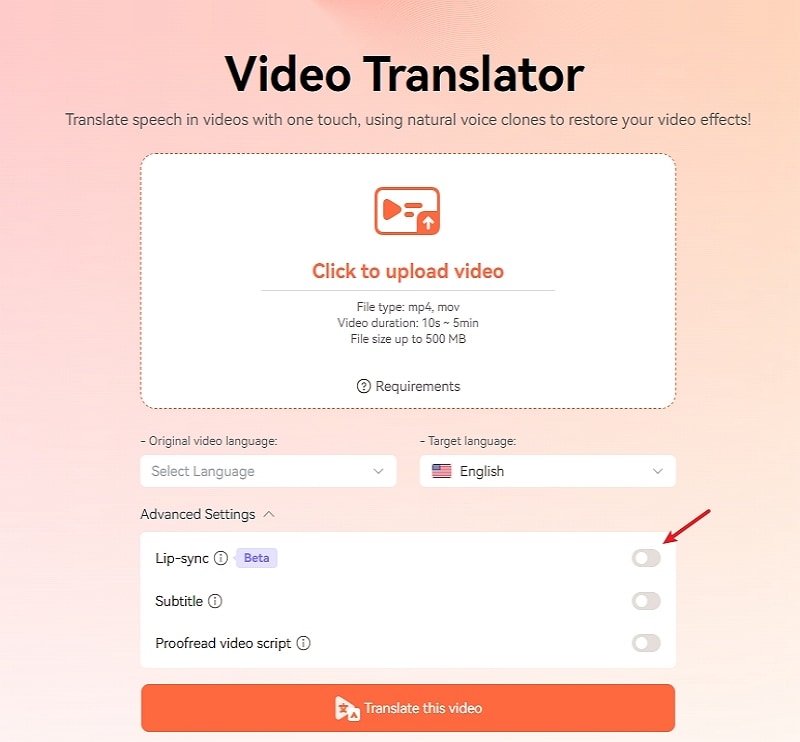
- Step 5. Click “Translate this video” to start translating the video.
Virbo’s Video Translator will use its advanced algorithms to translate the audio and synchronize it with the video seamlessly. Depending on the length and complexity of the video, the translation process may take some time.
Conclusion
Lip-syncing on TikTok has become a significant aspect of TikTok culture. It helps users show their creativity, entertain people, and maybe even become famous. Making mouth sync TikTok videos usually means remembering lines and matching them to music, but there’s an easier way with Wondershare Virbo’s Talking Photo tool. This tool allows you to upload a portrait and sync it with audio without remembering the lines.
Also, Wondershare Virbo has a Video Translator tool that allows you to translate videos seamlessly into any language. This translator tool helps you communicate with people worldwide and maintain the original message.
Also read:
- [New] 2024 Approved Crafting Captivating Thumbnails A Digital Marketer's Guidebook
- [New] Enhance Your Photography Journey Adding Music and Filters in Windows 10 Photos for 2024
- [New] Flavor Leaders Must-Watch Culinary YouTube Stars
- [New] Illuminating Colors The Grader's Journey
- [Updated] Cutting-Edge SplitCams Rated or Not, In 2024
- [Updated] Mastering Video Conferencing Combining the Power of ZOOM & SKYPE for 2024
- 10 Commandments of Eye-Catching Podcast Album Imagery for 2024
- Best Tool to Translate YouTube Video to Arabic for 2024
- How to Make Lip Sync Video Without Installing Any App
- How to Translate Instagram Videos for Global Engagement
- In 2024, Forgotten The Voicemail Password Of Realme 11X 5G? Try These Fixes
- In 2024, How To Unlock a Oppo F25 Pro 5G Easily?
- New 2024 Approved A Complete Guide of Top 7 Video Language Translators
- New A Complete Guide of Top 7 Video Language Translators
- Updated Best 5 Udemy Subtitle Translator (Auto Translation)
- Title: 2024 Approved Easy Steps to Translate Video on Twitter
- Author: Susan
- Created at : 2024-10-02 18:43:01
- Updated at : 2024-10-05 16:38:03
- Link: https://ai-video-translation.techidaily.com/2024-approved-easy-steps-to-translate-video-on-twitter/
- License: This work is licensed under CC BY-NC-SA 4.0.



